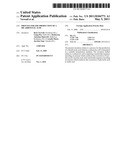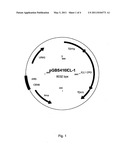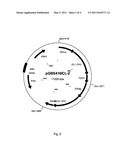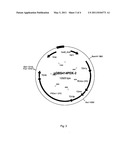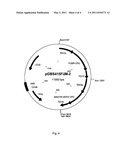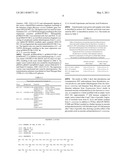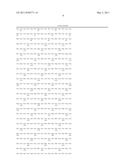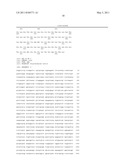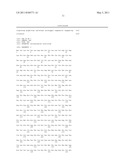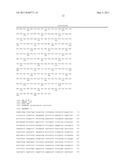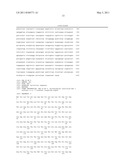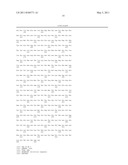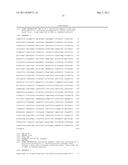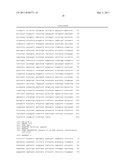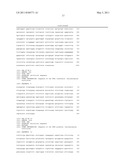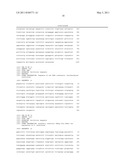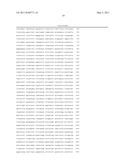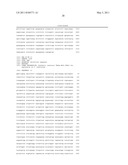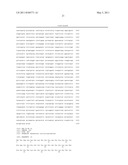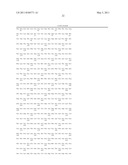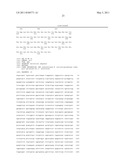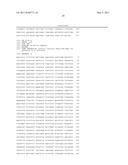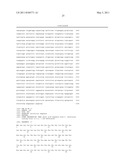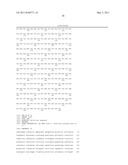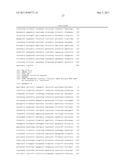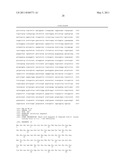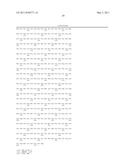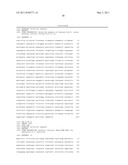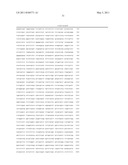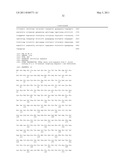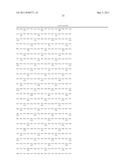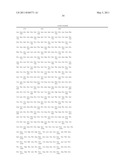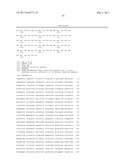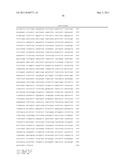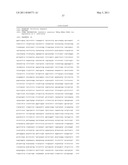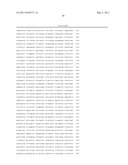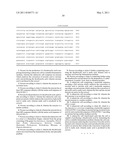Patent application title: PROCESS FOR THE PRODUCTION OF A DICARBOXYLIC ACID
Inventors:
Rene Verwall (Nootdorp, NL)
Liang Wu (Delft, NL)
Liang Wu (Delft, NL)
Robbertus Antonius Damveld (Berkel En Rodenrijs, NL)
Robbertus Antonius Damveld (Berkel En Rodenrijs, NL)
Cornells Maria Jacobus Sagt (Utrecht, NL)
IPC8 Class: AC12P746FI
USPC Class:
435145
Class name: Containing a carboxyl group polycarboxylic acid dicarboxylic acid having four or less carbon atoms (e.g., fumaric, maleic, etc.)
Publication date: 2011-05-05
Patent application number: 20110104771
Claims:
1. Process for the production of a dicarboxylic acid comprising
fermenting a eukaryotic cell in a suitable fermentation medium, wherein
the eukaryotic cell comprises an enzyme which catalyses the conversion of
isocitric acid to succinic acid, and producing the dicarboxylic acid,
wherein succinic acid is produced in the cytosol.
2. Process according to claim 1, wherein the enzyme is an isocitrate lyase.
3. Process according to claim 1 wherein the enzyme has at least 30% sequence identity with the amino acid sequence of SEQ ID NO: 1.
4. Process for the production of a dicarboxylic acid, optionally according to claim 1, wherein the eukaryotic cell comprises an enzyme which catalyses the conversion of glyoxylic acid to malic acid, wherein malic acid is produced in the cytosol.
5. Process according to claim 4, wherein the enzyme is a malate synthase.
6. Process according to claim 4, wherein the enzyme has at least 40% sequence identity with the amino acid sequence of SEQ ID NO: 5.
7. Process according to claim 1, wherein the eukaryotic cell is a yeast or a filamentous fungus, selected from the group consisting of the genus Saccharomyces, Aspergillus, Penicillium, Pichia, Kluyveromyces, Yarrowia, Candida, Hansenula, Trichosporon, Trichoderma, Rhizopus, or Zygosaccharomyces.
8. Process according to claim 1, wherein the dicarboxylic acid is recovered from the fermentation broth, and optionally purified.
9. Process according to claim 1 further comprising recovering the dicarboxylic acid is malic acid, fumaric acid or succinic acid from the fermentation medium.
10. Process according to claim 1 comprising further using the dicarboxylic acid produced for the preparation of a pharmaceutical, cosmetic, food, feed or chemical product.
11. A eukaryotic cell comprising a nucleotide sequence encoding a first enzyme which catalyses the conversion of isocitric acid to succinic acid, and a nucleotide sequence encoding a second enzyme which catalyses the conversion of glyoxylic acid to malic acid, wherein the first and the second enzyme are active in the cytosol.
12. A eukaryotic cell according to claim 11, wherein the first enzyme is an isocitrate lyase.
13. A eukaryotic cell according to claim 11, wherein the second enzyme is a malate synthase.
14. A eukaryotic cell according to claim 11, wherein the cell is a yeast.
15. A eukaryotic cell according to claim 11, which is a Saccharomyces cerevisiae comprising a nucleotide sequence of SEQ ID NO: 6 encoding an enzyme having isocitrate lyase activity and a nucleotide sequence of SEQ ID NO: 7 encoding an enzyme having malate synthase activity.
16. A eukaryotic cell transformed such that the cell is capable of producing a dicarboxylic acid by fermenting the cell in a suitable fermentation medium wherein the cell comprises an enzyme catalysing the conversion of isocitric acid to succinic acid, wherein succinic acid is produced in the cytosol and/or an enzyme that catalyses the conversion of glyoxylic acid to malic acid, wherein malic acid is produced in the cytosol.
Description:
[0001] The present invention relates to a process for the production of a
dicarboxylic acid and a eukaryotic cell comprising an enzyme that
catalyses the conversion of isocitric acid to succinic acid and an enzyme
that catalyses the conversion of glyoxylic acid to malic acid.
[0002] The 4-carbon dicarboxylic acids, malic acid, fumaric acid and succinic acid, are potential precursors for numerous chemicals and have numerous applications in pharmaceutical, cosmetic, food, feed or chemical industry.
[0003] Until date, malic acid, fumaric acid and succinic acid are predominantly produced through (petro) chemical processes, which are considered harmful to the environment and costly.
[0004] The fermentative production of dicarboxylic acids such as malic acid, fumaric acid and succinic acid may be an attractive alternative process for the production of these dicarboxylic acids, wherein renewable feedstock as a carbon source may be used.
[0005] A number of different bacteria such as Escherichia coli, and the rumen bacteria Actinobacillus, Anaerobiospirillum, Bacteroides, Mannheimia, or Succinimonas, sp. are known to produce succinic acid. Metabolic engineering of these bacterial strains have improved the succinic acid yield and/or productivity, or reduced the by-product formation.
[0006] WO2007/061590 discloses a pyruvate decarboxylase negative yeast for the production of malic acid and/or succinic acid which is transformed with a pyruvate carboxylase enzyme or a phosphoenolpyruvate carboxylase, a malate dehydrogenase enzyme, and a malic acid transporter protein.
[0007] Despite the improvements that have been made in the fermentative production of dicarboxylic acids, there remains a need for an improved production process of dicarboxylic acids.
[0008] The aim of the present invention is an improved process for the production of a dicarboxylic acid.
[0009] The aim is achieved according to the invention by a process for the production of a dicarboxylic acid comprising fermenting a eukaryotic cell in a suitable fermentation medium, wherein the eukaryotic cell comprises an enzyme which catalyses the
[0010] conversion of isocitric acid to succinic acid, and producing the dicarboxylic acid wherein succinic acid is produced in the cytosol. As understood herein, the conversion of isocitric acid to succinic acid comprises the formation of glyoxylic acid. Preferably, the eukaryotic cell in the process of the invention comprises an enzyme that catalyses the conversion of isocitric acid to succinic acid and glyoxylic acid.
[0011] Surprisingly, an increased amount of dicarboxylic acid was produced in the process according to the present invention, compared to a process wherein a eukaryotic cell is fermented which does not comprise an enzyme which catalyses the conversion of isocitric acid to succinic acid, wherein succinic acid is produced in the cytosol.
[0012] A suitable dicarboxylic acid that may be produced in the process according to the present invention is a 4-carbon dicarboxylic acid selected from malic acid, fumaric acid, and succinic acid. Preferably, the dicarboxylic acid is fumaric acid or succinic acid, in particular succinic acid.
[0013] As used herein, the terms dicarboxylic acid, malic acid, fumaric acid, succinic acid, isocitric acid and glyoxylic acid also cover the compounds dicarboxylate, malate, fumarate, succinate, isocitrate and glyoxylate, i.e. the ionic form of the acids, and salts, esters, or ethers thereof and the terms may be used interchangeably. The acid form is the hydrogenated form of the ionic form, and is influenced by the pH.
[0014] The eukaryotic cell fermented in the process according to the present invention may be a wild-type or a recombinant eukaryotic cell. As used herein, a recombinant eukaryotic cell is defined as a cell which contains a nucleotide sequence and/or protein, or is transformed or genetically modified with a nucleotide sequence that does not naturally occur in the yeast, or it contains additional copy or copies of an endogenous nucleic acid sequence (or protein). Commonly, a eukaryotic cell of the invention is a recombinant eukaryotic cell.
[0015] The enzyme which catalyses the conversion of isocitrate to succinate, may be any suitable heterologous or homologous enzyme. Preferably, the enzyme is an isocitrate lyase (EC 4.1.3.1).
[0016] The term "homologous" as used herein, refers to a nucleic acid (DNA or RNA) or polypeptide that is endogenous to, or found in nature in a cell or organism, genome, DNA, or RNA sequence.
[0017] The term "heterologous" as used herein, refers to a nucleic acid or polypeptide that is exogenous to, or does not occur naturally as part of the organism, cell, genome DNA or RNA sequence in which it is present.
[0018] For the production of a dicarboxylic acid such as succinic acid or malic acid in the cytosol, cytosolic localisation of the enzyme that catalyses the production of a dicarboxylic acid may be needed. The enzyme may be naturally present in the cytosol or cytosolic localisation may be obtained by deletion of a targeting sequence, for example a peroxisomal (or mitochondrial) targeting signal from the enzyme, in order to obtain cytosolic activity of the enzyme. The presence of a targeting signal may be identified by known methods in the art, for instance as determined by the method disclosed by Schluter et al, Nucleic acid Research 2007, Vol 25, D815-D822. A peroxisomal targeting signal is a region in a peroxisomal protein that binds to a receptor, which receptor directs the protein to the peroxisome. Peroxisomal proteins are synthesised in the cytosol. Deletion of a peroxisimal targeting signal will prevent peroxisomal targeting.
[0019] Preferably, a gene expressed in a eukaryotic cell of the invention encoding an enzyme that catalyses the production of a dicarboxylic acid, eg. an enzyme that catalyses the conversion of isocitrate to succinate or glyoxylate to malate, is expressed in the presence of a fermentable sugar.
[0020] Expression of a gene in the presence of a fermentable sugar may occur naturally, or may be obtained by deletion of glucose repression of the enzyme, for instance by replacing a promoter sensitive to glucose repression with a non-glucose repression sensitive promoter. Such promoters are known to the skilled person in the art.
[0021] Glucose repression is the repression of certain sugar-metabolizing operons in favour of glucose utilization wherein glucose is the predominant carbon source in the environment of the cell.
[0022] Preferably, an enzyme that catalyses the production of a dicarboxylic acid, eg. an enzyme that catalyses the conversion of isocitrate to succinate in the cytosol, is an enzyme that is not degraded or suppressed in the presence of a fermentable sugar, i.e. an enzyme that is not subjected to catabolite inactivation.
[0023] A nucleotide sequence encoding an enzyme that catalyses the conversion of isocitrate to succinate, wherein the enzyme is active in the cytosol, may encode a homologous or heterologous enzyme. Preferably, the enzyme is a heterologous enzyme.
[0024] Preferably, a eukaryotic cell in the process of the invention comprises an enzyme catalysing the conversion of isocitrate to succinate (and glyoxylate), which has at least 30%, preferably at least 40, 50, 60, 70, 75, 80, 85, 90, 95, 96, 97, 98, 99 or 100% sequence identity with the amino acid of SEQ ID NO: 1. Preferably, the enzyme catalysing the conversion of isocitrate to succinate is active in the cytosol.
[0025] The process according to the present invention was found particularly advantageous when the eukaryotic cell was fermented in a fermentation medium comprising a fermentable sugar. Fermentable sugars may be glucose, fructose, sucrose, maltose, galactose, raffinose, arabinose, xylose, or xylulose.
[0026] During the course of the process for the production of a dicarboxylic acid of the invention, a carbon source is converted to a dicarboxylic acid in a eukaryotic cell and secreted by the cell into the medium.
[0027] In another aspect the present invention relates to a process for the production of a dicarboxylic acid according to the present invention, wherein a eukaryotic cell is fermented which comprises a nucleotide sequence encoding an enzyme, which catalyses the conversion of glyoxylic acid to malic acid, wherein malic acid is produced in the cytosol.
[0028] Preferably, the process for the production of a dicarboxylic acid according to the present invention is a process wherein a eukaryotic cell is fermented which comprises an enzyme which catalyses the conversion of isocitric acid to succinic acid (and glyoxylic acid) and a second enzyme which catalyses the conversion of glyoxylic acid to malic acid, wherein succinic acid and malic acid are produced in the cytosol.
[0029] Surprisingly, it was found in the process according to the present invention that when succinic acid and/or malic acid were/was produced in the cytosol an increased amount of a dicarboxylic acid, in particular succinic acid was produced by the eukaryotic cell.
[0030] Preferably, the enzyme that catalyses the conversion of glyoxylate to malate in the eukaryotic cell of the invention is a malate synthase (EC 2.3.3.9). Cytosolic activity of an enzyme catalysing the conversion of glyoxylate to malate may be obtained as described herein above, preferably, by deletion of a peroxisomal targeting signal. In the event the malate synthase is a Saccharomyces cerevisiae malate synthase, preferably the native malate synthase is altered by the deletion of the SKL carboxy-terminal sequence.
[0031] Preferably, the nucleotide sequence encoding an enzyme that catalyses the conversion of glyoxylate to malate in the cytosol has at least 40%, preferably at least 50, 60, 70, 75, 80, 85, 90, 95, 96, 97, 98, 99, or 100% sequence identity to SEQ ID NO: 5.
[0032] Sequence identity is herein defined as a relationship between two or more amino acid (polypeptide or protein) sequences or two or more nucleic acid (polynucleotide) sequences, as determined by comparing the sequences. Usually, sequence identities are compared over the whole length of the sequences compared. In the art, "identity" also means the degree of sequence relatedness between amino acid or nucleic acid sequences, as the case may be, as determined by the match between strings of such sequences.
[0033] Preferred methods to determine identity are designed to give the largest match between the sequences tested. Methods to determine identity are codified in publicly available computer programs. Preferred computer program methods to determine identity and similarity between two sequences include e.g. the BLASTP, BLASTN), publicly available from NCBI and other sources (BLAST Manual, Altschul, S., et al., NCBI NLM NIH Bethesda, Md. 20894). Preferred parameters for amino acid sequences comparison using BLASTP are gap open 11.0, gap extension 1, Blosum 62 matrix.
[0034] A nucleotide sequence encoding an enzyme expressed in the cell of the invention may also be defined by their capability to hybridise with the nucleotide sequences encoding an enzyme of SEQ ID NO.'s: 1 or 5, under moderate, or preferably under stringent hybridisation conditions. Stringent hybridisation conditions are herein defined as conditions that allow a nucleic acid sequence of at least about 25, preferably about 50 nucleotides, 75 or 100 and most preferably of about 200 or more nucleotides, to hybridise at a temperature of about 65° C. in a solution comprising about 1 M salt, preferably 6×SSC (sodium chloride, sodium citrate) or any other solution having a comparable ionic strength, and washing at 65° C. in a solution comprising about 0.1 M salt, or less, preferably 0.2×SSC or any other solution having a comparable ionic strength. Preferably, the hybridisation is performed overnight, i.e. at least for 10 hours and preferably washing is performed for at least one hour with at least two changes of the washing solution. These conditions will usually allow the specific hybridisation of sequences having about 90% or more sequence identity.
[0035] Moderate conditions are herein defined as conditions that allow a nucleic acid sequence of at least 50 nucleotides, preferably of about 200 or more nucleotides, to hybridise at a temperature of about 45° C. in a solution comprising about 1 M salt, preferably 6×SSC or any other solution having a comparable ionic strength, and washing at room temperature in a solution comprising about 1 M salt, preferably 6×SSC or any other solution having a comparable ionic strength. Preferably, the hybridisation is performed overnight, i.e. at least for 10 hours, and preferably washing is performed for at least one hour with at least two changes of the washing solution. These conditions will usually allow the specific hybridisation of sequences having up to 50% sequence identity. The person skilled in the art will be able to modify these hybridisation conditions in order to specifically identify sequences varying in identity between 50% and 90%.
[0036] To increase the likelihood that an enzyme is expressed in active form in a eukaryotic cell of the invention, the corresponding encoding nucleotide sequence may be adapted to optimise its codon usage to that of the chosen eukaryotic host cell. Several methods for codon optimisation are known in the art. A preferred method to optimise codon usage of the nucleotide sequences to the eukaryotic cell according to the present invention is codon pair optimization technology as disclosed in WO2008/000632.
[0037] A eukaryotic cell in the process for the production of a dicarboxylic acid may be any suitable yeast or filamentous fungus. Preferably, a eukaryotic cell in the process according to the present invention belongs to the genera selected from the group consisting of Saccharomyces, Aspergillus, Penicillium, Pichia, Kluyveromyces, Candida, Hansenula, Trichosporon, Trichoderma, Rhizopus, and Zygosaccharomyces. Preferably, the eukaryotic cell belongs to a species Saccharomyces cerevisiae, Saccharomyces uvarum, Saccharomyces bayanus, Aspergillus niger, Penicillium chrysogenum, P. symplissicum, Pichia stipidis, P. pastoris, Kluyveromyces marxianus, K. lactis, K. thermotolerans, Trichoderma reesii, Candida sonorensis, C. glabrata, Rhizopus oryzae and Zygosaccharomyces bailii. The eukaryotic cell according to the present invention preferably belongs to a Saccharomyces sp., preferably a Saccharomyces cerevisiae.
[0038] The process for the production of a dicarboxylic acid according to the present invention may be run under aerobic, anaerobic, micro-aerophilic or oxygen limited conditions or a combination of aerobic and anaerobic/micro-aerophilic conditions. It may be preferred to grow the eukaryotic cell under aerobic conditions to a certain cell density and subsequently produce a dicarboxylic acid under anaerobic conditions, or micro-aerophilic or oxygen limited conditions.
[0039] An anaerobic fermentation process is herein defined as a fermentation process run in the absence of oxygen or in which substantially no oxygen is consumed, preferably less than 5, 2.5 or 1 mmol/L/Jh.
[0040] An oxygen-limited fermentation process is a process in which the oxygen consumption is limited by the oxygen transfer from the gas to the liquid. The degree of oxygen limitation is determined by the amount and composition of the ingoing gasflow as well as the actual mixing/mass transfer properties of the fermentation equipment used. Preferably, in a process under oxygen-limited conditions, the rate of oxygen consumption is at least 5.5, more preferably at least 6 and even more preferably at least 7 mmol/Uh.
[0041] The process for the production of a dicarboxylic acid according to the present invention may be carried out at any suitable pH between 1 and 9. Preferably, the pH in the fermentation broth is between 2 and 7, preferably between 2.5 and 6, preferably between 3 and 5.5, preferably between 3.5 and 5. It was found advantageous to be able to carry out the process according to the present invention at low pH, since this prevents bacterial contamination and less alkaline salts are needed for titration to maintain the pH at a desired level in the process for the production of succinate.
[0042] A suitable temperature at which the process according to the present invention may be carried out is between 5 and 60° C., preferably between 10 and 50° C., more preferably between 15 and 35° C., more preferably between 18° C. and 30° C. The skilled person in the art knows the optimal temperatures for fermenting a specific eukaryotic cell.
[0043] The process for the production of a dicarboxylic acid according to the present invention may be carried out in any suitable volume, preferably on an industrial scale. Preferably the process of the invention is carried out in a volume of at least 10 ml, 100 ml, 1 l, 10 l, 100 l, preferably at least 1 m3 (cubic metre), 10 m3 (cubic metre) or 100 m3 (cubic metre), and usually below 1000 m3 (cubic metre).
[0044] The fermentation medium may comprise any suitable component which allows optimal growth of and production of a dicarboxylic acid by a eukaryotic cell in the process according to the present invention, which are know to the skilled person. Preferably the fermentation medium comprises a source of carbon dioxide, for instance in the form of calcium carbonate or by flowing gaseous carbon dioxide through the medium.
[0045] In a preferred embodiment the process for the production of a dicarboxylic acid according to the present invention comprises recovering the dicarboxylic acid produced from the fermentation medium. Recovery of a dicarboxylic acid, such as malic acid, fumaric acid or succinic acid, from the fermentation medium may be carried out by any suitable method known in the art, for instance by crystallisation, ammomium precipitation or ion exchange technology. Preferably, the process for the production of a dicarboxylic acid further comprises purifying the dicarboxylic acid.
[0046] In another preferred embodiment, the process of the present invention comprises using a (fermentatively) produced dicarboxylic acid for the preparation of a product comprising a dicarboxylic acid or a derivative thereof. A derivative may for instance be esters, ethers, aldehydes, or salts of a dicarboxylic acid. Suitable products may for instance be a pharmaceutical, cosmetic, food, feed, or chemical product. Succinic acid and fumaric acid may be converted into their corresponding polyester polymers, such as polybutylenesuccinate (PBS). Succinic acid may also be converted by hydrogenation to 1,4-butanediol.
[0047] In another aspect, the present invention relates to a eukaryotic cell comprising a nucleotide sequence encoding a first enzyme which catalyses the conversion of isocitric acid to succinic acid, and a nucleotide sequence encoding a second enzyme which catalyses the conversion of glyoxylic acid to malic acid, wherein the first enzyme and the second enzyme are active in the cytosol. Commonly, the first enzyme in the eukaryotic cell of the invention catalyses the conversion of isocitric acid to succinic acid and glyoxylic acid.
[0048] Surprisingly, it was found that the eukaryotic cell according to the present invention produces an increased amount of a dicarboxylic acid, as compared to a eukaryotic cell which does not comprise an enzyme which catalyses the conversion of isocitric acid to succinic acid, and an enzyme which catalyses the conversion of glyoxylic acid to malic acid wherein both enzymes are active in the cytosol. A eukaryotic cell of the invention may advantageously be used in a process of the invention. The eukaryotic cell according to the present invention may be a yeast or a filamentous fungus, preferably according to a genus and species as defined herein above.
[0049] Preferred embodiments of an enzyme which catalyses the conversion of isocitrate to succinate and of an enzyme which catalyses the conversion of glyoxylate to malate in the eukaryotic cell according to the present invention and other preferred embodiments are as defined herein above.
[0050] Preferably, the eukaryotic cell according to the present invention is a Saccharomyces cerevisiae, preferably a Saccharomyces cerevisiae comprising a nucleotide sequence of SEQ ID NO: 6 encoding an enzyme having isocitrate lyase activity and a nucleotide sequence of SEQ ID NO: 7 encoding an enzyme having malate synthase activity.
[0051] Usually, a nucleotide sequence encoding an enzyme is operably linked to a promoter that causes sufficient expression of the corresponding nucleotide sequence in the eukaryotic cell according to the present invention to confer to the cell the ability to produce a dicarboxylic acid.
[0052] As used herein, the term "operably linked" refers to a linkage of polynucleotide elements (or coding sequences or nucleic acid sequence) in a functional relationship. A nucleic acid sequence is "operably linked" when it is placed into a functional relationship with another nucleic acid sequence. For instance, a promoter or enhancer is operably linked to a coding sequence if it affects the transcription of the coding sequence.
[0053] The term "promoter" refers to a nucleic acid fragment that functions to control the transcription of one or more genes, located upstream with respect to the direction of transcription of the transcription initiation site of the gene, and is structurally identified by the presence of a binding site for DNA-dependent RNA polymerase, transcription initiation sites and any other DNA sequences known to one of skilled in the art. A "constitutive" promoter is a promoter that is active under most environmental and developmental conditions. An "inducible" promoter is a promoter that is active under environmental or developmental regulation.
[0054] The promoter that could be used to achieve expression of a nucleotide sequence coding an enzyme in a eukaryotic cell of the invention, may be not native to the nucleotide sequence coding for the enzyme to be expressed, i.e. a promoter that is heterologous to the nucleotide sequence (coding sequence) to which it is operably linked. Preferably, the promoter is homologous, i.e. endogenous to the host cell.
[0055] Suitable promoters in eukaryotic cells are known to the skilled man in the art. Suitable promoters may be, but are not limited to TDH, GPDA, GAL7, GAL10, or GAL1, CYC1, HIS3, ADH1, PGL, PH05, ADC1, TRP1, URA3, LEU2, ENO, TPI, AOX1, PDC, GPD1, PGK1, and TEF1.
[0056] Usually a nucleotide sequence encoding an enzyme comprises a terminator. Any terminator, which is functional in the cell, may be used in the present invention. Preferred terminators are obtained from natural genes of the host cell. Suitable terminator sequences are well known in the art. Preferably, such terminators are combined with mutations that prevent nonsense mediated mRNA decay in the host cell of the invention (see for example: Shirley et al., 2002, Genetics 161:1465-1482).
[0057] The nucleotide sequence encoding an enzyme that catalyses the conversion of isocitrate to succinate and/or glyoxylate to malate may be overexpressed in the eukaryotic cell according to the present invention. There are known methods in the art for overexpression of nucleotide sequences encoding enzymes. A nucleotide sequence encoding an enzyme may be overexpressed by increasing the copy number of the gene coding for the enzyme in the cell, e.g. by integrating additional copies of the gene in the cell's genome, by expressing the gene from a centromeric vector, from an episomal multicopy expression vector or by introducing an (episomal) expression vector that comprises multiple copies of one or more gene(s). Preferably, overexpression of a nucleotide sequence encoding an enzyme according to the invention is achieved with a (strong) constitutive promoter.
[0058] In the scope of the present invention, the nucleotide sequence encoding an enzyme may be ligated into a nucleic acid construct, for instance a plasmid, such as a low copy plasmid or a high copy plasmid. The eukaryotic cell according to the present invention may comprise a single, or multiple copies of the nucleotide sequence encoding an enzyme, for instance by multiple copies of a nucleotide construct.
[0059] A nucleic acid construct may be maintained episomally and thus comprises a sequence for autonomous replication, such as an autosomal replication sequence. If the eukaryotic cell is of fungal origin, a suitable episomal nucleic acid construct may e.g. be based on the yeast 2μ or pKD1 plasmids (Gleer et al., 1991, Biotechnology 9: 968-975), or the AMA plasmids (Fierro et al., 1995, Curr Genet. 29:482-489). Alternatively, each nucleic acid construct may be integrated in one or more copies into the genome of the eukaryotic cell. Integration into the cell's genome may occur at random by non-homologous recombination but preferably, the nucleic acid construct may be integrated into the cell's genome by homologous recombination as is well known in the art.
[0060] In a preferred embodiment, a eukaryotic cell according to the present invention further comprises a nucleotide sequence encoding a heterologous PEP carboxykinase (EC 4.1.1.49) catalysing the reaction from phosphoenolpyruvate to oxaloacetate. Preferably, a PEP carboxykinase that is derived from bacteria, more preferably the enzyme having PEP carboxykinase activity is derived from Escherichia coli, Mannheimia sp., Actinobacillus sp., or Anaerobiospirillum sp., more preferably Mannheimia succiniciproducens, Actinobacillus succinogenes, or Anaerobiospirillum succiniciproducens.
[0061] In another preferred embodiment a eukaryotic cell according to the present invention further comprises a nucleotide sequence encoding a malate dehydrogenase (MDH) which is active in the cytosol upon expression of the nucleotide sequence. A cytosolic MDH may be any suitable homologous or heterologous malate dehydrogenase. The MDH may be a S. cerevisiae MDH3 or S. cerevisiae MDH1. Preferably, the MDH lacks a peroxisomal or mitochondrial targeting signal in order to localize the enzyme in the cytosol. Alternatively, the MDH is S. cerevisiae MDH2 which has been modified such that it is not inactivated in the presence of glucose and is active in the cytosol. It is known that the transcription of MDH2 is repressed and Mdh2p is degraded upon addition of glucose to glucose-starved cells. Mdh2p deleted for the first 12 amino-terminal amino acids is less-susceptible for glucose-induced degradation (Minard and McAlister-Henn, J. Biol. Chem. 1992 Aug. 25; 267(24):17458-64).
[0062] A eukaryotic cell according to the present invention may also comprise a nucleotide sequence encoding an enzyme that catalyses the conversion of malic acid to fumaric acid, which may be a heterologous or homologous enzyme. Preferably, the enzyme is active in the cytosol. An enzyme that catalyses the conversion of malic acid to fumaric acid, for instance a fumarase, may be derived from any suitable origin, preferably from microbial origin, for instance a yeast such as Saccharomyces or a filamentous fungus, such Rhizopus oryzae. Preferably, the nucleotide sequence encoding an enzyme catalyzing the conversion from malic acid to fumaric acid is overexpressed by methods as described herein above.
[0063] In another preferred embodiment a eukaryotic cell of the invention expresses a nucleotide sequence encoding an enzyme that catalyses the formation of succinic acid, wherein the nucleotide sequence preferably encodes a NAD(H)-dependent fumarate reductase. Preferably, the NADH-dependent fumarate reductase is a heterologous enzyme, which may be derived from any suitable origin, for instance bacteria, fungi, protozoa or plants. Preferably, the cell according to the invention comprises a heterologous NAD(H)-dependent fumarate reductase, preferably derived from a Trypanosoma sp. for instance a Trypanosoma brucei.
[0064] In a preferred embodiment the nucleotide sequence encoding a NAD(H)-dependent fumarate reductase is expressed in the cytosol. Surprisingly, cytosolic activity of the enzyme resulted in an increased productivity of succinic acid by the eukaryotic cell.
[0065] It was surprisingly found that additional (over)expression of genes encoding PEP carboxykinase, malate dehydrogenase, NAD(H) fumarate reductase, and/or fumarase as described herein in the eukaryotic cell of the invention resulted in increased succinic acid production levels.
[0066] Preferably, a eukaryotic cell according to the present invention is a cell wherein at least one gene encoding alcohol dehydrogenase is not functional. An alcohol dehydrogenase gene that is not functional is used herein to describe a eukaryotic cell, which comprises a reduced alcohol dehydrogenase activity compared to a cell wherein all genes encoding an alcohol dehydrogenase are functional. A gene may become not functional by known methods in the art, for instance by mutation, disruption, or deletion, for instance by the method disclosed by Gueldener et. al. 2002, Nucleic Acids Research, Vol. 30, No. 6, e23. Preferably, the cell is a Saccharomyces cerevisiae, wherein one or more of the genes ADH1 and/or ADH2, encoding alcohol dehydrogenase are inactivated.
[0067] Preferably, the cell according to the present invention further comprises at least one gene encoding glycerol-3-phosphate dehydrogenase which is not functional. A glycerol-3-phosphate dehydrogenase gene that is not functional is used herein to describe a eukaryotic cell, which comprises a reduced glycerol-3-phosphate dehydrogenase activity, for instance by mutation, disruption, or deletion of the gene encoding glycerol-3-phosphate dehydrogenase, resulting in a decreased formation of glycerol as compared to a cell wherein the at least one gene encoding glycerol-3-phosphate dehydrogenase is functional. Preferably, the cell is a Saccharomyces cerevisiae, wherein one or more of the genes GPD1 and/or GPD2, encoding glycerol-3-phosphate dehydrogenase are inactivated.
[0068] The present invention also relates to a eukaryotic cell transformed such that the cell is capable of producing a dicarboxylic acid by fermenting the cell in a suitable fermentation medium wherein the cell comprises an enzyme catalysing the conversion of isocitric acid to succinic acid (and glyoxylic acid), wherein succinic acid is produced in the cytosol and/or an enzyme that catalyses the conversion of glyoxylic acid to malic acid, wherein malic acid is produced in the cytosol. Preferably, the eukaryotic cell is transformed with enzymes as described above.
[0069] Genetic Modifications
[0070] Standard genetic techniques, such as overexpression of enzymes in the host cells, genetic modification of host cells, or hybridisation techniques, are known methods in the art, such as described in Sambrook and Russel (2001) "Molecular Cloning: A Laboratory Manual (3rd edition), Cold Spring Harbor Laboratory, Cold Spring Harbor Laboratory Press, or F. Ausubel et al, eds., "Current protocols in molecular biology", Green Publishing and Wiley Interscience, New York (1987). Methods for transformation, genetic modification etc of fungal host cells are known from e.g. EP-A-0 635 574, WO 98/46772, WO 99/60102 and WO 00/37671, WO90/14423, EP-A-0481008, EP-A-0635 574 and U.S. Pat. No. 6,265,186.
[0071] The following examples are for illustrative purposes only and are not to be construed as limiting the invention.
DESCRIPTION OF THE FIGURES
[0072] FIG. 1: Plasmid map of pGBS416ICL-1, encoding isocitrate lyase (ICL1) from K. lactis for expression in S. cerevisiae. CPO denotes codon pair optimized.
[0073] FIG. 2: Plasmid map of pGBS416ICL-2, encoding isocitrate lyase (ICL1) from K. lactis and malate synthase (MLS1) from S. cerevisiae for expression in S. cerevisiae. CPO denotes codon pair optimized.
[0074] FIG. 3: Plasmid map of pGBS414PEK-2, containing PEP carboxykinase from Mannheimia succiniciproducens (PCKm) and mitochondrial fumarate reductase m1 from Trypanosoma brucei (FRDm1) for expression in Saccharomyces cerevisiae. The synthetic gene constructs TDH1 promoter-PCKm-TDH1 terminator and TDH3 promoter-FRDm1-TDH3 terminator were cloned into expression vector pRS414. CPO denotes codon pair optimized.
[0075] FIG. 4: Plasmid map of pGBS415FUM-2, containing fumarase from Rhizopus oryzae (FUMR) and cytoplasmic malate dehydrogenase from Saccharomyces cerevisiae truncated for the first 12 amino acids (delta12N MDH2) for expression in Saccharomyces cerevisiae. The synthetic gene constructs TDH1 promoter-FUMR-TDH1 terminator and TDH3 promoter-delta12N MDH2-TDH3 terminator were cloned into expression vector pRS415. CPO denotes codon pair optimized.
EXAMPLES
Example 1A
Cloning of Isocitrate Lyase From K. lactis and Malate Synthase From Saccharomyces cerevisiae in Saccharomyces cerevisiae and Production of Dicarboxylic Acid
1A.1. Expression Constructs
[0076] Isocitrate lyase [E.C. 4.2.1.2], GenBank accession number 21724726, from Kluyveromyces lactis and malate synthase [E.C. 2.3.3.9], GenBank accession number 3964, from Saccharomyces cerevisiae were analysed for the presence of signal sequences using SignalP 3.0 (http://www.cbs.dtu.dk/services/SignalP/) Bendtsen, J. et al. (2004) Mol. Biol., 340:783-795 and TargetP 1.1 (http://www.cbs.dtu.dk/services/TargetP/) Emanuelsson, O. et al. (2007) Nature Protocols 2, 953-971. No targeting sequences were identified for isocitrate lyase from K. lactis, a putative 3 amino acid peroxisomal targeting sequence was identified at the C-terminus of malate synthase of S. cerevisiae.
[0077] SEQ ID NO: 1 was subjected to the codon-pair method as disclosed in WO2008/000632 for S. cerevisiae. The resulting sequence SEQ ID NO: 6 was put behind the constitutive TDH1 promoter sequence SEQ ID NO: 8 and before the TDH1 terminator sequence SEQ ID NO: 9, and convenient restriction sites were added. SEQ ID NO: 5, lacking the peroxisomal targeting signal was subjected to the codon-pair method as disclosed in WO2008/000632 for S. cerevisiae. The resulting sequence SEQ ID NO: 7 was put behind the constitutive TDH3 promoter sequence SEQ ID NO: 10 and before the TDH3 terminator sequence SEQ ID NO: 11, and convenient restriction sites were added. The resulting sequences were synthesised at Sloning (Puchheim, Germany). The expression construct pGBS416ICL-2 was created after a BamHI/NotI restriction of the S. cerevisiae expression vector pRS416 (Sirkoski R. S. and Hieter P, Genetics, 1989, 122(1):19-27) and subsequently ligating in this vector by a 3-point ligation a BamHI/Ascl restricted fragment consisting of the isocitrate lyase (origin K. lactis) synthetic gene construct and an Ascl/NotI restricted fragment consisting of the malate synthase (origin S. cerevisiae) synthetic gene construct (FIG. 1). The ligation mixture is used for transformation of E. coli DH10B (Invitrogen) resulting in the yeast expression construct pGBS416ICL-2 (FIG. 1).
[0078] The construct pGBS416ICL-2 is transformed into S. cerevisiae strains CEN.PK113-6B (MATA ura3-52 leu2-112 trp1-289), RWB066 (MATA ura3-52 leu2-112 trp1-289 adh1::lox adh2::Kanlox) and RWB064 (MATA ura3-52 leu2-112 trp1-289 adh1::lox adh2::lox gpd1::Kanlox). Transformation mixtures are plated on Yeast Nitrogen Base (YNB) w/o AA (Difco)+2% glucose supplemented with appropriate amino acids. Transformants are inoculated in Verduyn medium containing 4% glucose supplemented with appropriate amino acids (Verduyn et al., 1992, Yeast. July; 8(7):501-17) and CaCO3 and grown under aerobic, anaerobic and oxygen-limited conditions in shake flasks. The medium for anaerobic cultivation is supplemented with 0.01 g/l ergosterol and 0.42 g/l Tween 80 dissolved in ethanol (Andreasen and Stier, 1953, J. cell. Physiol, 41, 23-36; Andreasen and Stier, 1954, J. Cell. Physiol, 43: 271-281). All yeast cultures are grown at 30° C. in a shaking incubator at 250-280 rpm. At different incubation times, aliquots of the cultures are removed, centrifuged and the medium is analysed by HPLC for formation of oxalic acid, malic acid, fumaric acid and succinic acid as described below.
1A.2. HPLC Analysis
[0079] HPLC is performed for the determination of organic acids and sugars in different kinds of samples. The principle of the separation on a Phenomenex Rezex-RHM-Monosaccharide column is based on size exclusion, ion-exclusion and ion-exchange using reversed phase mechanisms. Detection takes place by differential refractive index and ultra violet detectors.
Example 1B
Cloning of Isocitrate Lyase From K. lactis and Malate Synthase From Saccharomyces cerevisiae in Saccharomyces cerevisiae and Production of Dicarboxylic Acid
1B.1. Expression Constructs
[0080] Potential targeting sequences of isocitrate lyase (ICL1 from K. lactis) or malate synthase (MLS1 from S. cerevisiae) were identified as disclosed in Example 1A.1. SEQ ID NO 1: was subjected to the codon-pair method as disclosed in WO2008/000632 for S. cerevisiae. The resulting sequence SEQ ID NO: 6 was put behind the constitutive TDH1 promoter sequence SEQ ID NO: 8 and before the TDH1 terminator sequence SEQ ID NO: 9, and convenient restriction sites were added. The resulting synthetic construct SEQ ID NO: 12 was synthesised at Sloning (Puchheim, Germany). SEQ ID NO: 5 was subjected to the codon-pair method as disclosed in WO2008/000632 for S. cerevisiae. The resulting sequence SEQ ID NO: 7 was put behind the constitutive TDH3 promoter sequence SEQ ID NO: 10 and before the TDH3 terminator sequence SEQ ID NO: 11, and convenient restriction sites were added. The resulting synthetic construct SEQ ID NO: 13 was synthesised at Sloning (Puchheim, Germany). The expression construct pGBS416ICL-1 was created after a BamHI/NotI restriction of the S. cerevisiae expression vector pRS416 (Sirkoski R. S. and Hieter P, Genetics, 1989, 122(1):19-27) and subsequently ligating in this vector a BamHI/NotI restriction fragment consisting of the isocitrate lyase (origin Kluveromyces lactis) synthetic gene construct (SEQ ID NO: 12). The ligation mixture was used for transformation of E. coli TOP10 (Invitrogen) resulting in the yeast expression construct pGBS416ICL-1 (FIG. 1). To create pGBS416ICL-2, pGBK416ICL-1 was restricted with Ascl and NotI. Subsequently, an Ascl/NotI restriction fragment consisting of MLS1 (origin S. cerevisiae) synthetic gene construct (SEQ ID NO: 13) was ligated into the restricted pGBS416ICL-1 vector, resulting in expression construct pGBS416ICL-2 (FIG. 2).
1B.2. Transformation
[0081] The constructs pGBS416ICL-1 and pGBS416ICL-2 were transformed into S. cerevisiae strain CEN.PK113-5D (MATA ura3-52), resulting in strains SUC-121 and SUC-122. As negative control, empty vector pRS416 was transformed into strain CEN.PK 113-5D, resulting in strain SUC-123. Transformation mixtures were plated on Yeast Nitrogen Base (YNB) w/o AA (Difco)+2% glucose.
1B.3. Growth Experiments
[0082] Transformants were inoculated in 20 ml pre-culture medium consisting of Verduyn medium (Verduyn et al., 1992, Yeast. July; 8(7):501-17) comprising 2% glucose (w/v) and grown under aerobic conditions in 100 ml shake flasks in a shaking incubator at 30° C. at 250 rpm. After 72 hours, the culture was centrifuged for 5 minutes at 4750 rpm. The supernatant was decanted and the pellet (cells) was resuspended in production medium. The production medium consisted of Verduyn medium with 10% glucose (w/v) and 1% CaCO3 (w/v). The cells were grown in 50 ml production medium in 100 ml shake flasks in a shaking incubator at 30° C. at 100 rpm. After 4 and 7 days incubation, a 1 ml sample was taken from the culture and succinic acid levels were measured by HPLC as described in section 1A.2. The results are shown in Table 1.
TABLE-US-00001 TABLE 1 Effect of introduction of isocitrate lyase from K. lactis and malate synthase from S. cerevisiae in S. cerevisiae on succinic acid production levels after 4 and 7 days of incubation in shake flask. Results are the average of 3 individual growth experiments. S. cerevisiae Over- Succinic Succinic strain comprising expressed acid (mg/l) acid (mg/l) plasmid: genes after 4 days after 7 days pGBS416ICL-1 ICL1 399 ± 6 460 ± 11 (SUC-121) pGBS416ICL-2 ICL1, MLS1 420 ± 24 477 ± 36 (SUC-122) pRS416 (empty) -- 332 ± 20 394 ± 22 (SUC-123)
[0083] The results in Table 1 show that introduction and overexpression of isocitrate lyase (ICL1) from K. lactis resulted in increased succinic acid production levels (1.20 fold after 4 days incubation and 1.17 fold after 7 days compared to the empty vector control strain). Furthermore, introduction and overexpression of isocitrate lyase (ICL1) from K. lactis and additional overexpression of malate synthase (MLS1) from S. cerevisiae resulted in increased succinic acid production levels (1.27 fold after 4 days incubation and 1.21 fold after 7 days compared to the empty vector control strain).
Example 1C
Expression Isocitrate Lyase From Kluyveromyces lactis and Malate Synthase From Saccharomyces cerevisiae in Addition to PEP Carboxykinase From Mannheimia succiniciproducens and Malate Dehydrogenase from Saccharomyces cerevisiae and Fumarase from Rhizopus oryzae and Fumarate Reductase From Trypanosoma brucei in Saccharomyces cerevisiae
1C.1. Gene Sequences
Phosphoenolpyruvate Carboxykinase:
[0084] Phosphoenolpyruvate carboxykinase [E.C. 4.1.1.49], GenBank accession number 52426348, from Mannheimia succiniciproducens was analysed for the presence of signal sequences as described in Schluter et al., (2007) NAR, 35, D815-D822. The sequence as shown in SEQ ID NO: 14 required no modifications. SEQ ID NO: 14 was subjected to the codon-pair method as disclosed in WO2008/000632 for S. cerevisiae. The stop codon TAA in the resulting sequence SEQ ID NO: 15 was modified to TAAG. SEQ ID NO: 15 containing stop codon TAAG was put behind the constitutive TDH1 promoter sequence SEQ ID NO: 8 and before the TDH1 terminator sequence SEQ ID NO: 9. Convenient restriction sites were added. The resulting synthetic construct (SEQ ID NO: 16) was synthesised at Stoning (Puchheim, Germany).
Malate Dehydrogenase
[0085] Cytoplasmic malate dehydrogenase (Mdh2p) [E.C. 1.1.1.37], GenBank accession number 171915, is regulated by carbon catabolite repression: transcription of MDH2 is repressed and Mdh2p is degraded upon addition of glucose to glucose-starved cells. Mdh2p deleted for the 12 amino-terminal amino acids is less-susceptible for glucose-induced degradation (Minard and McAlister-Henn, J Biol. Chem. 1992 Aug. 25; 267(24):17458-64). To avoid glucose-induced degradation of Mdh2, the nucleotides encoding the first 12 amino acids were removed, and a new methionine amino acid was introduced (SEQ ID NO: 17) for overexpression of Mdh2 in S. cerevisiae. SEQ ID NO: 17 was subjected to the codon-pair method as disclosed in WO2008/000632 for S. cerevisiae. The stop codon TAA in the resulting in SEQ ID NO: 18, was modified to TAAG. SEQ ID NO: 18 containing a modified stop codon TAAG, encoding delta12NMDH2, was put behind the constitutive TDH3 promoter sequence SEQ ID NO: 10 and before the TDH3 terminator sequence SEQ ID NO: 11, and convenient restriction sites were added. The resulting synthetic construct (SEQ ID NO: 19) was synthesised at Sloning (Puchheim, Germany).
Fumarase:
[0086] Fumarase [E.C. 4.2.1.2], GenBank accession number 469103, from Rhizopus oryzae (FumR) was analysed for the presence of signal sequences using SignalP 3.0 (http://www.cbs.dtu.dk/services/SignalP/) Bendtsen, J. et al. (2004) Mol. Biol., 340:783-795 and TargetP 1.1 (http://www.cbs.dtu.dk/services/TargetP/) Emanuelsson, O. et al. (2007) Nature Protocols 2, 953-971. A putative mitochondrial targeting sequence in the first 23 amino acid of the protein was identified. To avoid potential targeting to mitochondria in S. cerevisiae, the first 23 amino acids were removed from FumR and a methionine amino acid was reintroduced resulting in SEQ ID NO: 20. SEQ ID NO: 20 was subjected to the codon-pair method as disclosed in WO2008/000632 for S. cerevisiae resulting in SEQ ID NO: 21. The stop codon TAA in SEQ ID NO: 21 was modified to TAAG. SEQ ID NO: 21 containing TAAG as stop codon was synthesized behind the constitutive TDH1 promoter sequence SEQ ID NO: 8 and before the TDH1 terminator sequence SEQ ID NO: 9 and convenient restriction sites were added. The resulting synthetic construct SEQ ID NO: 22 was synthesised at Sloning (Puchheim, Germany).
Fumarate Reductase:
[0087] Mitochondrial fumarate reductase m1 (FRDm1) [E.C. 1.3.1.6], GenBank accession number 60460035, from Trypanosoma brucei was analysed for the presence of signal sequences using SignalP 3.0 (http://www.cbs.dtu.dk/services/SignalP/) Bendtsen, J. et al. (2004) Mol. Biol., 340:783-795 and TargetP 1.1 (http://www.cbs.dtu.dk/services/TargetP) Emanuelsson, O. et al. (2007) Nature Protocols 2, 953-971. A putative mitochondrial targeting sequence in the N-terminal half of the protein was identified, including a possible cleavage site between pos. 25 and 26 (D-S).
[0088] It was shown that FRDm1 recombinant protein lacking the 68 N-terminal residues, relocalized to the cytosol of the procyclic trypanosomes (Coustou et al., J Biol. Chem. 2005 Apr. 29; 280(17):16559-70). These results indicate that the predicted N-terminal signal motif of FRDm1 is required for targeting to the mitochondrion. To avoid potential targeting to mitochondria in S. cerevisiae, the first 68 amino acids were removed from the mitochondrial fumarate reductase amino acid sequence and a methionine amino acid was reintroduced resulting in SEQ ID NO: 23. SEQ ID NO: 23 codon optimized as disclosed in WO2008/000632 for expression in S. cerevisiae. The stop codon TGA in SEQ ID NO: 24 was modified to TAAG. The resulting sequence SEQ ID NO: 24 was put behind the constitutive TDH3 promoter sequence SEQ ID NO: 10 and before the TDH3 terminator sequence SEQ ID NO: 11, and convenient restriction sites were added. The resulting synthetic construct SEQ ID NO: 25 was synthesised at Sloning (Puchheim, Germany).
1C.2. Construction of Expression Constructs
[0089] The expression construct pGBS414PEK-2 (FIG. 3) was created after a BamHI/NotI restriction of the S. cerevisiae expression vector pRS414 (Sirkoski R. S. and Hieter P, Genetics, 1989, 122(1):19-27) and subsequently ligating in this vector a BamHI/NotI restriction fragment consisting of the phosphoenolpyruvate carboxykinase (origin Mannheimia succiniciproducens) synthetic gene construct (SEQ ID NO: 16). The ligation mix was used for transformation of E. coli TOP10 (Invitrogen) resulting in the yeast expression construct pGBS414PEK-1. Subsequently, pGBK414PEK-1 was restricted with Ascl and NotI. To create pGBS414PEK-2, an Ascl/NotI restriction fragment consisting of mitochondrial fumarate reductase from T. brucei (FRDm1) synthetic gene construct (SEQ ID NO: 25) was ligated into the restricted pGBS414PEK-1 vector. The ligation mix was used for transformation of E. coli TOP10 (Invitrogen) resulting in the yeast expression construct pGBS414PEK-2 (FIG. 3).
[0090] The expression construct pGBS415FUM-2 (FIG. 4) was created after a BamHI/NotI restriction of the S. cerevisiae expression vector pRS415 (Sirkoski R. S. and Hieter P, Genetics, 1989, 122(1):19-27) and subsequently ligating in this vector a BamHI/NotI restriction fragment consisting of the fumarase (origin Rhizopus oryzae) synthetic gene construct (SEQ ID NO: 22). The ligation mix was used for transformation of E. coli TOP10 (Invitrogen) resulting in the yeast expression construct pGBS415FUM-1. Subsequently, pGBK415FUM-1 was restricted with Ascl and NotI. To create pGBS415FUM-2, an Ascl/NotI restriction fragment consisting of cytoplasmic malate dehydrogenase from S. cerevisiae (delta12N MDH2) synthetic gene construct (SEQ ID NO: 19) was ligated into the restricted pGBS415FUM-1 vector. The ligation mix was used for transformation of E. coli TOP10 (Invitrogen) resulting in the yeast expression construct pGBS415FUM-2 (FIG. 4).
1C.3. S. cerevisiae Strains
[0091] Plasmids pGBS414PEK-2, pGBS415FUM-2 and pGBS416ICL-2 or pRS416 were transformed into S. cerevisiae strain CEN.PK113-6B (MATA ura3-52 leu2-112 trp1-289), resulting in the yeast strains depicted in Table 2. An empty vector control strain was created by transformation of pRS414, pRS415 and pRS416 empty vectors (Sirkoski R. S. and Hieter P, Genetics, 1989, 122(1):19-27). The expression vectors were transformed into yeast by electroporation. The transformation mixtures were plated on Yeast Nitrogen Base (YNB) w/o AA (Difco)+2% glucose.
TABLE-US-00002 TABLE 2 Yeast strains constructed for Example 1C. Name Background Plasmids Genes SUC-131 CEN.PK113-6B pGBS414PEK-2 PCKm, FRDm1 pGBS415FUM-2 FUMR, delta12N MDH2 pRS416ICL-2 ICL1, MLS1 SUC-132 CEN.PK113-6B pGBS414PEK-2 PCKm, FRDm1 pGBS415FUM-2 FUMR, delta12N MDH2 pRS416 (empty vector) SUC-101 CEN.PK113-6B pRS414 (empty vector) pRS415 (empty vector) pRS416 (empty vector)
1C.4. Growth Experiments and Succinic Acid Production
[0092] Transformants were grown and samples were taken as described in section 1B.3. Succinic acid levels were measured by HPLC as described in section 1A.2. The results are shown in Table 3.
TABLE-US-00003 TABLE 3 Effect of introduction of isocitrate lyase from Kluyveromyces lactis and malate synthase from Saccharomyces cerevisiae in addition to PEP carboxykinase from Mannheimia succiniciproducens and malate dehydrogenase from Saccharomyces cerevisiae and fumarase from Rhizopus oryzae and fumarate reductase from Trypanosoma brucei on succinic acid production in Saccharomyces cerevisiae. Data represent values as measured in supernatant of cells grown in shake flask cultures. The number of individual growth experiments is indicated. Succinic acid (g/l) Succinic acid (g/l) Strain: after 4 days after 7 days SUC-131 (ICL1, MLS1) 6.02 ± 0.27 (n = 3) 6.34 ± 0.16 (n = 3) SUC-132 (control) 5.76 ± 0.32 (n = 3) 5.90 ± 0.30 (n = 3) SUC-101 (empty vector 0.34 ± 0.01 (n = 6) 0.34 ± 0.02 (n = 6) control)
[0093] The results in Table 3 show that introduction and overexpression PEP carboxykinase from Mannheimia succiniciproducens and malate dehydrogenase from Saccharomyces cerevisiae and fumarase from Rhizopus oryzae and fumarate reductase from Trypanosoma brucei results in increased succinic acid production in Saccharomyces cerevisiae, as compared to a strain modified with an empty vector (SUC-101, approximately 17 fold increase compared to empty vector control after 4 and 7 days of growth). Expression of isocitrate lyase from K. lactis and malate synthase from S. cerevisiae in addition to PCKm, delta12N MDH2, FUMR and FRDm1 resulted in a further increase in succinic acid production levels (1.05 fold after 4 and 1.07 fold increase after 7 days of growth), thus showing a positive effect of the glyoxylate cycle on succinic acid production in S. cerevisiae.
Sequence CWU
1
251542PRTKluyveromyces lactis 1Met Val Ser Val Lys Ala Ser Ala Ala Glu Lys
Lys Glu Phe Leu Gln1 5 10
15Ser Gln Ile Asp Glu Ile Glu Lys Trp Trp Ser Glu Pro Arg Trp Lys
20 25 30Asp Thr Lys Arg Ile Tyr Ser
Ala Tyr Glu Ile Ala Lys Arg Arg Gly 35 40
45Ser Val Lys Pro Asn Thr Phe Pro Ser Thr Val Met Ser Gln Lys
Leu 50 55 60Phe Lys Ile Leu Gly Glu
His Ala Lys Asn Gly Thr Val Ser Lys Thr65 70
75 80Phe Gly Ala Leu Asp Pro Val Gln Val Thr Gln
Met Ser Lys Tyr Leu 85 90
95Asp Thr Ile Tyr Val Ser Gly Trp Gln Cys Ser Ser Thr Ala Ser Thr
100 105 110Ser Asn Glu Pro Gly Pro
Asp Leu Ala Asp Tyr Pro Met Asp Thr Val 115 120
125Pro Asn Lys Val Glu His Leu Phe Lys Ala Gln Gln Phe His
Asp Arg 130 135 140Lys Gln Trp Glu Arg
Ile Cys Asp Gly Thr Ile Glu Glu Ser Glu Ile145 150
155 160Ile Asp Tyr Leu Thr Pro Ile Val Ala Asp
Gly Asp Ala Gly His Gly 165 170
175Gly Leu Thr Ala Val Phe Lys Leu Thr Lys Met Phe Ile Glu Arg Gly
180 185 190Ala Ala Gly Ile His
Ile Glu Asp Gln Thr Ser Thr Asn Lys Lys Cys 195
200 205Gly His Met Ala Gly Arg Cys Val Ile Pro Val Gln
Glu His Ile Asn 210 215 220Arg Leu Ile
Thr Cys Arg Met Ala Ala Asp Val Leu Gly Ser Asp Leu225
230 235 240Ile Leu Val Ala Arg Thr Asp
Ser Glu Ala Ala Thr Leu Leu Ser Ser 245
250 255Thr Ala Asp Ser Arg Asp His Tyr Phe Ile Leu Gly
Ala Ser Asn Pro 260 265 270Ala
Val Lys Gly Lys Pro Leu Asn Asp Leu Leu Asn Lys Ala Ile Leu 275
280 285Asp Gly Ala Thr Ile Asp Asp Leu Gln
Thr Ile Glu Lys Glu Trp Leu 290 295
300Ala Lys Ala Asp Val Lys Leu Phe His Glu Val Phe Ala Asp Ala Ala305
310 315 320Lys Ala Ala Gly
Lys Asp Gln Ser Val Ile Asp Gln Phe Asn Ser Lys 325
330 335Val Asn Pro Leu Ser Glu Thr Ser Ile Tyr
Glu Met Gln Ala Leu Ala 340 345
350Lys Glu Leu Leu Gly Thr Glu Leu Phe Phe Asp Trp Asp Leu Pro Arg
355 360 365Gly Arg Glu Gly Leu Tyr Arg
Tyr Gln Gly Gly Thr Gln Cys Ser Val 370 375
380Met Arg Ala Arg Ala Phe Ala Pro Tyr Ala Asp Leu Cys Trp Met
Glu385 390 395 400Ser Asn
Tyr Pro Asp Tyr Glu Gln Ala Lys Glu Phe Ala Glu Gly Val
405 410 415Thr Ala Lys Phe Pro Gly Lys
Trp Met Ala Tyr Asn Leu Ser Pro Ser 420 425
430Phe Asn Trp Thr Lys Ala Met Ser Val Asp Glu Gln Glu Thr
Phe Ile 435 440 445Gln Arg Leu Gly
Asp Leu Gly Tyr Ile Trp Gln Phe Ile Thr Leu Ala 450
455 460Gly Leu His Thr Ser Gly Leu Ala Ile Glu Gln Phe
Ser Lys Asn Phe465 470 475
480Ala Lys Leu Gly Met Lys Ala Tyr Ala Gln Asp Ile Gln Lys Lys Glu
485 490 495Leu Asp Asn Gly Ile
Asp Met Val Lys His Gln Lys Trp Ser Gly Ala 500
505 510Glu Tyr Ile Asp Gly Leu Leu Arg Leu Ala Gln Gly
Gly Leu Ala Ala 515 520 525Thr Ala
Ala Met Gly Gln Gly Val Thr Glu Asp Gln Phe Lys 530
535 54021629DNAKluyveromyces lactis 2atggtctccg
ttaaggcttc tgctgctgaa aagaaggaat tcttacaaag tcaaattgac 60gaaattgaga
aatggtggtc cgaacctcgt tggaaggaca ccaaacgtat ctactctgct 120tacgaaattg
caaagagacg tggttcagta aaaccaaata ctttcccatc tactgtgatg 180tctcaaaaat
tgttcaaaat cttgggggaa cacgctaaga acggcactgt ctccaagact 240ttcggtgctt
tggaccctgt tcaagtgacc caaatgtcta agtacttgga taccatttac 300gtttcaggct
ggcaatgttc ttccactgca tcaacttcta acgaaccggg tccagatttg 360gctgattacc
caatggacac tgtaccaaac aaagtggagc atttgttcaa ggctcaacaa 420ttccatgaca
gaaaacaatg ggaacgtatc tgtgatggta ccattgaaga atctgaaatc 480attgactatt
tgactccaat cgttgctgat ggtgacgctg gtcatggtgg tttgactgct 540gtcttcaagt
tgacaaaaat gttcatcgaa agaggagctg ccggtatcca cattgaagat 600caaacttcta
caaacaaaaa gtgtggtcac atggctggta gatgtgttat cccagtacaa 660gaacatatta
acagattgat cacttgtaga atggctgcag atgttttggg ttcagatttg 720atccttgttg
ccagaactga ttctgaagcc gctactctat tatcctctac tgccgattca 780agggaccatt
acttcatctt gggtgcttcc aatccagccg tcaagggtaa accattgaac 840gatttactga
acaaagctat cttggacggt gccaccatcg atgacttaca aaccatcgaa 900aaagaatggt
tggccaaggc cgacgttaag ctgttccacg aagtattcgc tgacgctgcc 960aaggctgcag
gtaaggacca atccgtaatt gaccaattca acagcaaagt caacccatta 1020agtgaaacat
caatctatga aatgcaagcc ttggccaagg aattgttggg taccgaattg 1080ttcttcgact
gggacttgcc aagaggccgt gaaggtttgt accgttacca aggtggtact 1140cagtgttctg
tgatgagagc tcgtgccttt gctccatacg ctgatctatg ttggatggaa 1200tctaactacc
ctgattacga acaagctaag gaattcgctg aaggtgtcac agctaagttc 1260ccaggcaagt
ggatggctta caacttgtca ccatctttca actggacaaa agctatgtct 1320gtcgacgaac
aagagacatt cattcaaaga ttgggtgact tgggttacat ctggcaattt 1380atcactttag
ctggtctaca tacaagtggt ttagccatcg aacaattctc caagaatttc 1440gccaagttag
gaatgaaggc atatgctcaa gatatccaaa agaaggaatt ggataacggt 1500atcgacatgg
taaagcacca gaaatggtct ggtgctgaat atatcgatgg tctattaaga 1560ttagcacaag
gtggtctcgc tgccactgct gctatgggtc aaggtgtcac tgaggatcag 1620ttcaaataa
16293554PRTSaccharomyces cerevisiae 3Met Val Lys Val Ser Leu Asp Asn Val
Lys Leu Leu Val Asp Val Asp1 5 10
15Lys Glu Pro Phe Phe Lys Pro Ser Ser Thr Thr Val Gly Asp Ile
Leu 20 25 30Thr Lys Asp Ala
Leu Glu Phe Ile Val Leu Leu His Arg Thr Phe Asn 35
40 45Asn Lys Arg Lys Gln Leu Leu Glu Asn Arg Gln Val
Val Gln Lys Lys 50 55 60Leu Asp Ser
Gly Ser Tyr His Leu Asp Phe Leu Pro Glu Thr Ala Asn65 70
75 80Ile Arg Asn Asp Pro Thr Trp Gln
Gly Pro Ile Leu Ala Pro Gly Leu 85 90
95Ile Asn Arg Ser Thr Glu Ile Thr Gly Pro Pro Leu Arg Asn
Met Leu 100 105 110Ile Asn Ala
Leu Asn Ala Pro Val Asn Thr Tyr Met Thr Asp Phe Glu 115
120 125Asp Ser Ala Ser Pro Thr Trp Asn Asn Met Val
Tyr Gly Gln Val Asn 130 135 140Leu Tyr
Asp Ala Ile Arg Asn Gln Ile Asp Phe Asp Thr Pro Arg Lys145
150 155 160Ser Tyr Lys Leu Asn Gly Asn
Val Ala Asn Leu Pro Thr Ile Ile Val 165
170 175Arg Pro Arg Gly Trp His Met Val Glu Lys His Leu
Tyr Val Asp Asp 180 185 190Glu
Pro Ile Ser Ala Ser Ile Phe Asp Phe Gly Leu Tyr Phe Tyr His 195
200 205Asn Ala Lys Glu Leu Ile Lys Leu Gly
Lys Gly Pro Tyr Phe Tyr Leu 210 215
220Pro Lys Met Glu His His Leu Glu Ala Lys Leu Trp Asn Asp Val Phe225
230 235 240Cys Val Ala Gln
Asp Tyr Ile Gly Ile Pro Arg Gly Thr Ile Arg Ala 245
250 255Thr Val Leu Ile Glu Thr Leu Pro Ala Ala
Phe Gln Met Glu Glu Ile 260 265
270Ile Tyr Gln Leu Arg Gln His Ser Ser Gly Leu Asn Cys Gly Arg Trp
275 280 285Asp Tyr Ile Phe Ser Thr Ile
Lys Arg Leu Arg Asn Asp Pro Asn His 290 295
300Ile Leu Pro Asn Arg Asn Gln Val Thr Met Thr Ser Pro Phe Met
Asp305 310 315 320Ala Tyr
Val Lys Arg Leu Ile Asn Thr Cys His Arg Arg Gly Val His
325 330 335Ala Met Gly Gly Met Ala Ala
Gln Ile Pro Ile Lys Asp Asp Pro Ala 340 345
350Ala Asn Glu Lys Ala Met Thr Lys Val Arg Asn Asp Lys Ile
Arg Glu 355 360 365Leu Thr Asn Gly
His Asp Gly Ser Trp Val Ala His Pro Ala Leu Ala 370
375 380Pro Ile Cys Asn Glu Val Phe Ile Asn Met Gly Thr
Pro Asn Gln Ile385 390 395
400Tyr Phe Ile Pro Glu Asn Val Val Thr Ala Ala Asn Leu Leu Glu Thr
405 410 415Lys Ile Pro Asn Gly
Glu Ile Thr Thr Glu Gly Ile Val Gln Asn Leu 420
425 430Asp Ile Gly Leu Gln Tyr Met Glu Ala Trp Leu Arg
Gly Ser Gly Cys 435 440 445Val Pro
Ile Asn Asn Leu Met Glu Asp Ala Ala Thr Ala Glu Val Ser 450
455 460Arg Cys Gln Leu Tyr Gln Trp Val Lys His Gly
Val Thr Leu Lys Asp465 470 475
480Thr Gly Glu Lys Val Thr Pro Glu Leu Thr Glu Lys Ile Leu Lys Glu
485 490 495Gln Val Glu Arg
Leu Ser Lys Ala Ser Pro Leu Gly Asp Lys Asn Lys 500
505 510Phe Ala Leu Ala Ala Lys Tyr Phe Leu Pro Glu
Ile Arg Gly Glu Lys 515 520 525Phe
Ser Glu Phe Leu Thr Thr Leu Leu Tyr Asp Glu Ile Val Ser Thr 530
535 540Lys Ala Thr Pro Thr Asp Leu Ser Lys
Leu545 55041665DNASaccharomyces cerevisiae 4atggttaagg
tcagtttgga taacgtcaaa ttactggtgg atgttgataa ggagcctttc 60tttaaaccat
ctagtactac agtgggagat attcttacca aggatgctct agagttcatt 120gttcttttac
acagaacttt caacaacaag agaaaacaat tattggaaaa cagacaagtt 180gttcagaaga
aattagactc gggctcctat catctggatt tcctgcctga aactgcaaat 240attagaaatg
atcccacttg gcaaggtcca attttggcac cggggttaat taataggtca 300acggaaatca
cagggcctcc attgagaaat atgctgatca acgctttgaa tgctcctgtg 360aacacctata
tgactgattt tgaagattca gcttcaccta cttggaacaa catggtttac 420ggtcaagtta
atctctacga cgcgatcaga aatcaaatcg attttgacac accaagaaaa 480tcgtacaaat
tgaatggaaa tgtggccaac ttgcccacta ttatcgtgag accccgtggt 540tggcacatgg
tggaaaagca cctttatgta gatgatgaac caatcagcgc ttccatcttt 600gattttggtt
tatatttcta ccataatgcc aaagaattaa tcaaattggg caaaggtcct 660tacttctatt
tgccaaagat ggagcaccac ttggaagcta aactatggaa cgacgtcttc 720tgtgtagctc
aagattacat tgggatccca aggggtacaa tcagagctac tgtgttgatt 780gaaactttgc
ctgctgcttt ccaaatggaa gagatcatct atcaattaag acaacattct 840agtgggttga
attgcggacg ttgggactat attttctcta caatcaagag attaagaaat 900gatcctaatc
acattttgcc caatagaaat caagtgacta tgacttcccc attcatggat 960gcatacgtga
aaagattaat caatacctgt catcggaggg gtgttcatgc catgggtggt 1020atggctgcgc
aaatccctat caaagacgac ccggcagcca atgaaaaggc catgactaaa 1080gtccgtaatg
ataagattag agagctgaca aatggacatg atgggtcatg ggttgcacac 1140ccagcactgg
cccctatttg taatgaagtt ttcattaata tgggaacacc aaaccaaatc 1200tatttcattc
ctgaaaacgt tgtaacggct gctaatctgc tggaaaccaa aattccaaat 1260ggtgagatta
ctaccgaggg aattgtacaa aacttggata tcgggttgca gtacatggaa 1320gcttggctca
gaggctctgg atgtgtgccc atcaacaact tgatggaaga cgccgccact 1380gctgaagtgt
ctcgttgtca attgtatcaa tgggtgaaac acggtgttac tctaaaggac 1440acgggagaaa
aggtcacccc agaattaacc gaaaagattc taaaagaaca agtggaaaga 1500ctgtctaagg
caagtccatt gggtgacaag aacaaattcg cgctggccgc taagtatttc 1560ttgccagaaa
tcagaggcga gaaattcagt gaatttttga ctacattgtt gtacgacgaa 1620attgtgtcca
ctaaggcgac gcccactgat ttgagcaaat tgtga
16655551PRTArtificial sequenceSEQ ID NO 5 Saccharomyces cerevisiae MLS 1
lacking 3 a.a. C terminal targeting signal 5Met Val Lys Val Ser Leu
Asp Asn Val Lys Leu Leu Val Asp Val Asp1 5
10 15Lys Glu Pro Phe Phe Lys Pro Ser Ser Thr Thr Val
Gly Asp Ile Leu 20 25 30Thr
Lys Asp Ala Leu Glu Phe Ile Val Leu Leu His Arg Thr Phe Asn 35
40 45Asn Lys Arg Lys Gln Leu Leu Glu Asn
Arg Gln Val Val Gln Lys Lys 50 55
60Leu Asp Ser Gly Ser Tyr His Leu Asp Phe Leu Pro Glu Thr Ala Asn65
70 75 80Ile Arg Asn Asp Pro
Thr Trp Gln Gly Pro Ile Leu Ala Pro Gly Leu 85
90 95Ile Asn Arg Ser Thr Glu Ile Thr Gly Pro Pro
Leu Arg Asn Met Leu 100 105
110Ile Asn Ala Leu Asn Ala Pro Val Asn Thr Tyr Met Thr Asp Phe Glu
115 120 125Asp Ser Ala Ser Pro Thr Trp
Asn Asn Met Val Tyr Gly Gln Val Asn 130 135
140Leu Tyr Asp Ala Ile Arg Asn Gln Ile Asp Phe Asp Thr Pro Arg
Lys145 150 155 160Ser Tyr
Lys Leu Asn Gly Asn Val Ala Asn Leu Pro Thr Ile Ile Val
165 170 175Arg Pro Arg Gly Trp His Met
Val Glu Lys His Leu Tyr Val Asp Asp 180 185
190Glu Pro Ile Ser Ala Ser Ile Phe Asp Phe Gly Leu Tyr Phe
Tyr His 195 200 205Asn Ala Lys Glu
Leu Ile Lys Leu Gly Lys Gly Pro Tyr Phe Tyr Leu 210
215 220Pro Lys Met Glu His His Leu Glu Ala Lys Leu Trp
Asn Asp Val Phe225 230 235
240Cys Val Ala Gln Asp Tyr Ile Gly Ile Pro Arg Gly Thr Ile Arg Ala
245 250 255Thr Val Leu Ile Glu
Thr Leu Pro Ala Ala Phe Gln Met Glu Glu Ile 260
265 270Ile Tyr Gln Leu Arg Gln His Ser Ser Gly Leu Asn
Cys Gly Arg Trp 275 280 285Asp Tyr
Ile Phe Ser Thr Ile Lys Arg Leu Arg Asn Asp Pro Asn His 290
295 300Ile Leu Pro Asn Arg Asn Gln Val Thr Met Thr
Ser Pro Phe Met Asp305 310 315
320Ala Tyr Val Lys Arg Leu Ile Asn Thr Cys His Arg Arg Gly Val His
325 330 335Ala Met Gly Gly
Met Ala Ala Gln Ile Pro Ile Lys Asp Asp Pro Ala 340
345 350Ala Asn Glu Lys Ala Met Thr Lys Val Arg Asn
Asp Lys Ile Arg Glu 355 360 365Leu
Thr Asn Gly His Asp Gly Ser Trp Val Ala His Pro Ala Leu Ala 370
375 380Pro Ile Cys Asn Glu Val Phe Ile Asn Met
Gly Thr Pro Asn Gln Ile385 390 395
400Tyr Phe Ile Pro Glu Asn Val Val Thr Ala Ala Asn Leu Leu Glu
Thr 405 410 415Lys Ile Pro
Asn Gly Glu Ile Thr Thr Glu Gly Ile Val Gln Asn Leu 420
425 430Asp Ile Gly Leu Gln Tyr Met Glu Ala Trp
Leu Arg Gly Ser Gly Cys 435 440
445Val Pro Ile Asn Asn Leu Met Glu Asp Ala Ala Thr Ala Glu Val Ser 450
455 460Arg Cys Gln Leu Tyr Gln Trp Val
Lys His Gly Val Thr Leu Lys Asp465 470
475 480Thr Gly Glu Lys Val Thr Pro Glu Leu Thr Glu Lys
Ile Leu Lys Glu 485 490
495Gln Val Glu Arg Leu Ser Lys Ala Ser Pro Leu Gly Asp Lys Asn Lys
500 505 510Phe Ala Leu Ala Ala Lys
Tyr Phe Leu Pro Glu Ile Arg Gly Glu Lys 515 520
525Phe Ser Glu Phe Leu Thr Thr Leu Leu Tyr Asp Glu Ile Val
Ser Thr 530 535 540Lys Ala Thr Pro Thr
Asp Leu545 55061629DNAArtificial sequenceSEQ ID NO 6
Nucleotide sequence codon pair optimized for S. cerevisiae encoding
for K. lactis isocitrate lyase (Icl1). (Stop codon TAA is TAAT in
ordered construct) 6atggtttccg tcaaggcttc tgctgctgaa aagaaggaat
tcttgcaatc tcaaatcgat 60gaaattgaaa aatggtggtc tgaaccaaga tggaaggaca
ccaagagaat ctactctgct 120tacgaaattg ccaagcgtcg tggttctgtc aagccaaaca
ctttcccatc taccgtcatg 180tctcaaaaat tgttcaagat cttaggtgaa cacgctaaga
acggtactgt ttccaagact 240ttcggtgctt tggaccctgt tcaagtcact caaatgtcca
agtacttgga caccatctac 300gtttccggtt ggcaatgttc ctctactgct tccacttcta
acgaaccagg tccagatttg 360gctgactacc caatggacac cgttccaaac aaggttgaac
atttgttcaa ggctcaacaa 420ttccacgaca gaaagcaatg ggaaagaatc tgtgatggta
ccattgaaga atctgaaatc 480attgactact tgactccaat tgttgctgat ggtgatgctg
gtcacggtgg tttgactgct 540gtcttcaagt tgaccaagat gttcatcgaa agaggtgctg
ctggtattca cattgaagat 600caaacctcta ccaacaagaa atgtggtcac atggctggta
gatgtgtcat tccagttcaa 660gaacacatca acagattaat cacctgtaga atggctgctg
atgtcttggg ttctgacttg 720atcttagtcg ccagaactga ctctgaagct gctactttgt
tgtcctccac tgctgactct 780cgtgaccatt atttcatctt aggtgcttcc aacccagctg
tcaagggtaa gcctttgaat 840gacttgttga acaaggccat cttggatggt gctaccatcg
atgacttgca aaccattgaa 900aaggaatggt tagccaaggc tgatgtcaaa ttattccacg
aagttttcgc tgatgctgcc 960aaggctgctg gtaaggacca atctgtcatt gaccaattca
actccaaggt taacccattg 1020tctgaaacct ccatctacga aatgcaagct ttggccaagg
aattgttggg tactgaattg 1080ttcttcgact gggacttgcc aagaggtaga gaaggtctat
acagatacca aggtggtact 1140caatgttctg ttatgagagc cagagccttt gctccatacg
ctgatctatg ttggatggaa 1200tccaactacc cagactacga acaagccaag gaatttgctg
aaggtgttac cgccaagttc 1260ccaggtaaat ggatggctta caacttgtct ccatctttca
actggaccaa ggccatgtct 1320gttgacgaac aagaaacttt catccaaaga ttaggtgact
tgggttacat ctggcaattc 1380atcactttgg ctggtttgca cacctctggt ttggccattg
aacaattctc caagaacttt 1440gccaaattgg gtatgaaggc ttacgctcaa gatatccaaa
agaaggaatt ggacaacggt 1500attgacatgg ttaagcacca aaaatggtcc ggtgctgaat
acatcgatgg tttgttgaga 1560ttggctcaag gtggtttggc tgctaccgct gccatgggtc
aaggtgtcac tgaagatcaa 1620ttcaagtaa
162971656DNAArtificial sequenceNucleotide sequence
codon pair optimized for S. cerevisiae encoding for S. cerevisiae
malate synthase (Mls1), lacking 3 amino acid C-terminal targeting
signal. (Stop codon TAA is TAAT in ordered construct) 7atggtcaagg
tttctttgga caatgtcaaa ttgttagtcg atgttgacaa ggaacctttc 60ttcaagcctt
cttccaccac cgttggtgac atcttgacca aggatgcttt ggaattcatt 120gtcttgttgc
acagaacttt caacaacaag agaaagcaat tgttggaaaa cagacaagtt 180gttcaaaaga
aattggactc tggttcttac catttggact tcttgccaga aactgctaac 240atcagaaacg
acccaacctg gcaaggtcca attttggctc caggtttgat caacagatcc 300actgaaatca
ctggtcctcc attgagaaac atgttgatca atgctttgaa tgctccagtt 360aacacctaca
tgactgactt cgaagattct gcctctccaa cctggaacaa catggtttac 420ggtcaagtca
acttatacga tgctatcaga aaccaaattg acttcgacac tccaagaaaa 480tcttacaaat
tgaacggtaa cgttgccaac ttgccaacca ttattgtcag accaagaggt 540tggcacatgg
ttgaaaagca tttatacgtt gacgacgaac caatttctgc ctccattttc 600gatttcggtc
tatatttcta ccataacgct aaggaattga tcaagttggg taagggtcca 660tacttctact
tgccaaagat ggaacaccac ttggaagcta agttgtggaa cgatgttttc 720tgtgttgctc
aagactacat tggtattcca agaggtacca tcagagctac tgttttgatt 780gaaactttac
cagctgcttt ccaaatggaa gaaatcatct accaattgag acaacactcc 840tctggtttga
actgtggtag atgggactac atcttttcca ccatcaagag attgagaaac 900gacccaaacc
acattttgcc aaacagaaac caagtcacca tgacttctcc attcatggac 960gcttacgtca
agagattgat caacacctgt caccgtcgtg gtgtccacgc tatgggtggt 1020atggctgctc
aaattccaat caaggatgac ccagctgcca acgaaaaggc catgaccaag 1080gtcagaaacg
acaagatcag agaattaacc aacggtcacg atggttcctg ggttgctcac 1140ccagctttgg
ctccaatctg taacgaagtc tttatcaaca tgggtactcc aaaccaaatc 1200tacttcattc
cagaaaacgt tgtcactgct gctaacttgt tggaaaccaa gattccaaac 1260ggtgaaatca
ccactgaagg tattgtccaa aacttggata tcggtttgca atacatggaa 1320gcttggttac
gtggttctgg ttgtgttcca atcaacaact tgatggaaga tgccgctact 1380gctgaagttt
cccgttgtca attgtaccaa tgggttaagc acggtgtcac tttgaaagac 1440accggtgaaa
aggtcactcc agaattgact gaaaagatct taaaggaaca agttgaaaga 1500ttatccaaag
cctctccatt aggtgacaag aacaagttcg ctctagccgc caaatacttc 1560ttgccagaaa
tcagaggtga aaagttctct gaatttttga ccactttgtt gtacgatgaa 1620attgtctcca
ccaaggctac tccaaccgat ttgtaa
165681000DNAArtificial sequenceSequence of the TDH1 promoter
(Saccharomyces cerevisiae) 8cttccctttt acagtgcttc ggaaaagcac
agcgttgtcc aagggaacaa tttttcttca 60agttaatgca taagaaatat ctttttttat
gtttagctaa gtaaaagcag cttggagtaa 120aaaaaaaaat gagtaaattt ctcgatggat
tagtttctca caggtaacat aacaaaaacc 180aagaaaagcc cgcttctgaa aactacagtt
gacttgtatg ctaaagggcc agactaatgg 240gaggagaaaa agaaacgaat gtatatgctc
atttacactc tatatcacca tatggaggat 300aagttgggct gagcttctga tccaatttat
tctatccatt agttgctgat atgtcccacc 360agccaacact tgatagtatc tactcgccat
tcacttccag cagcgccagt agggttgttg 420agcttagtaa aaatgtgcgc accacaagcc
tacatgactc cacgtcacat gaaaccacac 480cgtggggcct tgttgcgcta ggaataggat
atgcgacgaa gacgcttctg cttagtaacc 540acaccacatt ttcagggggt cgatctgctt
gcttccttta ctgtcacgag cggcccataa 600tcgcgctttt tttttaaaag gcgcgagaca
gcaaacagga agctcgggtt tcaaccttcg 660gagtggtcgc agatctggag actggatctt
tacaatacag taaggcaagc caccatctgc 720ttcttaggtg catgcgacgg tatccacgtg
cagaacaaca tagtctgaag aaggggggga 780ggagcatgtt cattctctgt agcagtaaga
gcttggtgat aatgaccaaa actggagtct 840cgaaatcata taaatagaca atatattttc
acacaatgag atttgtagta cagttctatt 900ctctctcttg cataaataag aaattcatca
agaacttggt ttgatatttc accaacacac 960acaaaaaaca gtacttcact aaatttacac
acaaaacaaa 10009500DNAArtificial sequenceSequence
of the TDH1 terminator (Saccharomyces cerevisiae) 9ataaagcaat
cttgatgagg ataatgattt ttttttgaat atacataaat actaccgttt 60ttctgctaga
ttttgtgaag acgtaaataa gtacatatta ctttttaagc caagacaaga 120ttaagcatta
actttaccct tttctcttct aagtttcaat actagttatc actgtttaaa 180agttatggcg
agaacgtcgg cggttaaaat atattaccct gaacgtggtg aattgaagtt 240ctaggatggt
ttaaagattt ttcctttttg ggaaataagt aaacaatata ttgctgcctt 300tgcaaaacgc
acatacccac aatatgtgac tattggcaaa gaacgcatta tcctttgaag 360aggtggatac
tgatactaag agagtctcta ttccggctcc acttttagtc cagagattac 420ttgtcttctt
acgtatcaga acaagaaagc atttccaaag taattgcatt tgcccttgag 480cagtatatat
atactaagaa
500101000DNAArtificial sequenceSequence of the TDH3 promoter
(Saccharomyces cerevisiae) 10ctattttcga ggaccttgtc accttgagcc
caagagagcc aagatttaaa ttttcctatg 60acttgatgca aattcccaaa gctaataaca
tgcaagacac gtacggtcaa gaagacatat 120ttgacctctt aacaggttca gacgcgactg
cctcatcagt aagacccgtt gaaaagaact 180tacctgaaaa aaacgaatat atactagcgt
tgaatgttag cgtcaacaac aagaagttta 240atgacgcgga ggccaaggca aaaagattcc
ttgattacgt aagggagtta gaatcatttt 300gaataaaaaa cacgcttttt cagttcgagt
ttatcattat caatactgcc atttcaaaga 360atacgtaaat aattaatagt agtgattttc
ctaactttat ttagtcaaaa aattagcctt 420ttaattctgc tgtaacccgt acatgcccaa
aatagggggc gggttacaca gaatatataa 480catcgtaggt gtctgggtga acagtttatt
cctggcatcc actaaatata atggagcccg 540ctttttaagc tggcatccag aaaaaaaaag
aatcccagca ccaaaatatt gttttcttca 600ccaaccatca gttcataggt ccattctctt
agcgcaacta cagagaacag gggcacaaac 660aggcaaaaaa cgggcacaac ctcaatggag
tgatgcaacc tgcctggagt aaatgatgac 720acaaggcaat tgacccacgc atgtatctat
ctcattttct tacaccttct attaccttct 780gctctctctg atttggaaaa agctgaaaaa
aaaggttgaa accagttccc tgaaattatt 840cccctacttg actaataagt atataaagac
ggtaggtatt gattgtaatt ctgtaaatct 900atttcttaaa cttcttaaat tctactttta
tagttagtct tttttttagt tttaaaacac 960caagaactta gtttcgaata aacacacata
aacaaacaaa 100011500DNAArtificial
sequenceSequence of the TDH3 terminator (Saccharomyces cerevisiae)
11gtgaatttac tttaaatctt gcatttaaat aaattttctt tttatagctt tatgacttag
60tttcaattta tatactattt taatgacatt ttcgattcat tgattgaaag ctttgtgttt
120tttcttgatg cgctattgca ttgttcttgt ctttttcgcc acatgtaata tctgtagtag
180atacctgata cattgtggat gctgagtgaa attttagtta ataatggagg cgctcttaat
240aattttgggg atattggctt ttttttttaa agtttacaaa tgaatttttt ccgccaggat
300aacgattctg aagttactct tagcgttcct atcggtacag ccatcaaatc atgcctataa
360atcatgccta tatttgcgtg cagtcagtat catctacatg aaaaaaactc ccgcaatttc
420ttatagaata cgttgaaaat taaatgtacg cgccaagata agataacata tatctagatg
480cagtaatata cacagattcc
500123160DNAArtificial sequenceSynthetic construct TDH1p-ICL1-TDH1t for
expression in S. cerevisiae 12ggatcccttc ccttttacag tgcttcggaa
aagcacagcg ttgtccaagg gaacaatttt 60tcttcaagtt aatgcataag aaatatcttt
ttttatgttt agctaagtaa aagcagcttg 120gagtaaaaaa aaaaatgagt aaatttctcg
atggattagt ttctcacagg taacataaca 180aaaaccaaga aaagcccgct tctgaaaact
acagttgact tgtatgctaa agggccagac 240taatgggagg agaaaaagaa acgaatgtat
atgctcattt acactctata tcaccatatg 300gaggataagt tgggctgagc ttctgatcca
atttattcta tccattagtt gctgatatgt 360cccaccagcc aacacttgat agtatctact
cgccattcac ttccagcagc gccagtaggg 420ttgttgagct tagtaaaaat gtgcgcacca
caagcctaca tgactccacg tcacatgaaa 480ccacaccgtg gggccttgtt gcgctaggaa
taggatatgc gacgaagacg cttctgctta 540gtaaccacac cacattttca gggggtcgat
ctgcttgctt cctttactgt cacgagcggc 600ccataatcgc gctttttttt taaaaggcgc
gagacagcaa acaggaagct cgggtttcaa 660ccttcggagt ggtcgcagat ctggagactg
gatctttaca atacagtaag gcaagccacc 720atctgcttct taggtgcatg cgacggtatc
cacgtgcaga acaacatagt ctgaagaagg 780gggggaggag catgttcatt ctctgtagca
gtaagagctt ggtgataatg accaaaactg 840gagtctcgaa atcatataaa tagacaatat
attttcacac aatgagattt gtagtacagt 900tctattctct ctcttgcata aataagaaat
tcatcaagaa cttggtttga tatttcacca 960acacacacaa aaaacagtac ttcactaaat
ttacacacaa aacaaaatgg tttccgtcaa 1020ggcttctgct gctgaaaaga aggaattctt
gcaatctcaa atcgatgaaa ttgaaaaatg 1080gtggtctgaa ccaagatgga aggacaccaa
gagaatctac tctgcttacg aaattgccaa 1140gcgtcgtggt tctgtcaagc caaacacttt
cccatctacc gtcatgtctc aaaaattgtt 1200caagatctta ggtgaacacg ctaagaacgg
tactgtttcc aagactttcg gtgctttgga 1260ccctgttcaa gtcactcaaa tgtccaagta
cttggacacc atctacgttt ccggttggca 1320atgttcctct actgcttcca cttctaacga
accaggtcca gatttggctg actacccaat 1380ggacaccgtt ccaaacaagg ttgaacattt
gttcaaggct caacaattcc acgacagaaa 1440gcaatgggaa agaatctgtg atggtaccat
tgaagaatct gaaatcattg actacttgac 1500tccaattgtt gctgatggtg atgctggtca
cggtggtttg actgctgtct tcaagttgac 1560caagatgttc atcgaaagag gtgctgctgg
tattcacatt gaagatcaaa cctctaccaa 1620caagaaatgt ggtcacatgg ctggtagatg
tgtcattcca gttcaagaac acatcaacag 1680attaatcacc tgtagaatgg ctgctgatgt
cttgggttct gacttgatct tagtcgccag 1740aactgactct gaagctgcta ctttgttgtc
ctccactgct gactctcgtg accattattt 1800catcttaggt gcttccaacc cagctgtcaa
gggtaagcct ttgaatgact tgttgaacaa 1860ggccatcttg gatggtgcta ccatcgatga
cttgcaaacc attgaaaagg aatggttagc 1920caaggctgat gtcaaattat tccacgaagt
tttcgctgat gctgccaagg ctgctggtaa 1980ggaccaatct gtcattgacc aattcaactc
caaggttaac ccattgtctg aaacctccat 2040ctacgaaatg caagctttgg ccaaggaatt
gttgggtact gaattgttct tcgactggga 2100cttgccaaga ggtagagaag gtctatacag
ataccaaggt ggtactcaat gttctgttat 2160gagagccaga gcctttgctc catacgctga
tctatgttgg atggaatcca actacccaga 2220ctacgaacaa gccaaggaat ttgctgaagg
tgttaccgcc aagttcccag gtaaatggat 2280ggcttacaac ttgtctccat ctttcaactg
gaccaaggcc atgtctgttg acgaacaaga 2340aactttcatc caaagattag gtgacttggg
ttacatctgg caattcatca ctttggctgg 2400tttgcacacc tctggtttgg ccattgaaca
attctccaag aactttgcca aattgggtat 2460gaaggcttac gctcaagata tccaaaagaa
ggaattggac aacggtattg acatggttaa 2520gcaccaaaaa tggtccggtg ctgaatacat
cgatggtttg ttgagattgg ctcaaggtgg 2580tttggctgct accgctgcca tgggtcaagg
tgtcactgaa gatcaattca agtaatgccc 2640gggcataaag caatcttgat gaggataatg
attttttttt gaatatacat aaatactacc 2700gtttttctgc tagattttgt gaagacgtaa
ataagtacat attacttttt aagccaagac 2760aagattaagc attaacttta cccttttctc
ttctaagttt caatactagt tatcactgtt 2820taaaagttat ggcgagaacg tcggcggtta
aaatatatta ccctgaacgt ggtgaattga 2880agttctagga tggtttaaag atttttcctt
tttgggaaat aagtaaacaa tatattgctg 2940cctttgcaaa acgcacatac ccacaatatg
tgactattgg caaagaacgc attatccttt 3000gaagaggtgg atactgatac taagagagtc
tctattccgg ctccactttt agtccagaga 3060ttacttgtct tcttacgtat cagaacaaga
aagcatttcc aaagtaattg catttgccct 3120tgagcagtat atatatacta agaaggcgcg
ccgcggccgc 3160133195DNAArtificial
sequenceSynthetic construct TDH3p-MLS1-TDH3t for expression in S.
cerevisiae 13ggatccggcg cgccctattt tcgaggacct tgtcaccttg agcccaagag
agccaagatt 60taaattttcc tatgacttga tgcaaattcc caaagctaat aacatgcaag
acacgtacgg 120tcaagaagac atatttgacc tcttaacagg ttcagacgcg actgcctcat
cagtaagacc 180cgttgaaaag aacttacctg aaaaaaacga atatatacta gcgttgaatg
ttagcgtcaa 240caacaagaag tttaatgacg cggaggccaa ggcaaaaaga ttccttgatt
acgtaaggga 300gttagaatca ttttgaataa aaaacacgct ttttcagttc gagtttatca
ttatcaatac 360tgccatttca aagaatacgt aaataattaa tagtagtgat tttcctaact
ttatttagtc 420aaaaaattag ccttttaatt ctgctgtaac ccgtacatgc ccaaaatagg
gggcgggtta 480cacagaatat ataacatcgt aggtgtctgg gtgaacagtt tattcctggc
atccactaaa 540tataatggag cccgcttttt aagctggcat ccagaaaaaa aaagaatccc
agcaccaaaa 600tattgttttc ttcaccaacc atcagttcat aggtccattc tcttagcgca
actacagaga 660acaggggcac aaacaggcaa aaaacgggca caacctcaat ggagtgatgc
aacctgcctg 720gagtaaatga tgacacaagg caattgaccc acgcatgtat ctatctcatt
ttcttacacc 780ttctattacc ttctgctctc tctgatttgg aaaaagctga aaaaaaaggt
tgaaaccagt 840tccctgaaat tattccccta cttgactaat aagtatataa agacggtagg
tattgattgt 900aattctgtaa atctatttct taaacttctt aaattctact tttatagtta
gtcttttttt 960tagttttaaa acaccaagaa cttagtttcg aataaacaca cataaacaaa
caaaatggtc 1020aaggtttctt tggacaatgt caaattgtta gtcgatgttg acaaggaacc
tttcttcaag 1080ccttcttcca ccaccgttgg tgacatcttg accaaggatg ctttggaatt
cattgtcttg 1140ttgcacagaa ctttcaacaa caagagaaag caattgttgg aaaacagaca
agttgttcaa 1200aagaaattgg actctggttc ttaccatttg gacttcttgc cagaaactgc
taacatcaga 1260aacgacccaa cctggcaagg tccaattttg gctccaggtt tgatcaacag
atccactgaa 1320atcactggtc ctccattgag aaacatgttg atcaatgctt tgaatgctcc
agttaacacc 1380tacatgactg acttcgaaga ttctgcctct ccaacctgga acaacatggt
ttacggtcaa 1440gtcaacttat acgatgctat cagaaaccaa attgacttcg acactccaag
aaaatcttac 1500aaattgaacg gtaacgttgc caacttgcca accattattg tcagaccaag
aggttggcac 1560atggttgaaa agcatttata cgttgacgac gaaccaattt ctgcctccat
tttcgatttc 1620ggtctatatt tctaccataa cgctaaggaa ttgatcaagt tgggtaaggg
tccatacttc 1680tacttgccaa agatggaaca ccacttggaa gctaagttgt ggaacgatgt
tttctgtgtt 1740gctcaagact acattggtat tccaagaggt accatcagag ctactgtttt
gattgaaact 1800ttaccagctg ctttccaaat ggaagaaatc atctaccaat tgagacaaca
ctcctctggt 1860ttgaactgtg gtagatggga ctacatcttt tccaccatca agagattgag
aaacgaccca 1920aaccacattt tgccaaacag aaaccaagtc accatgactt ctccattcat
ggacgcttac 1980gtcaagagat tgatcaacac ctgtcaccgt cgtggtgtcc acgctatggg
tggtatggct 2040gctcaaattc caatcaagga tgacccagct gccaacgaaa aggccatgac
caaggtcaga 2100aacgacaaga tcagagaatt aaccaacggt cacgatggtt cctgggttgc
tcacccagct 2160ttggctccaa tctgtaacga agtctttatc aacatgggta ctccaaacca
aatctacttc 2220attccagaaa acgttgtcac tgctgctaac ttgttggaaa ccaagattcc
aaacggtgaa 2280atcaccactg aaggtattgt ccaaaacttg gatatcggtt tgcaatacat
ggaagcttgg 2340ttacgtggtt ctggttgtgt tccaatcaac aacttgatgg aagatgccgc
tactgctgaa 2400gtttcccgtt gtcaattgta ccaatgggtt aagcacggtg tcactttgaa
agacaccggt 2460gaaaaggtca ctccagaatt gactgaaaag atcttaaagg aacaagttga
aagattatcc 2520aaagcctctc cattaggtga caagaacaag ttcgctctag ccgccaaata
cttcttgcca 2580gaaatcagag gtgaaaagtt ctctgaattt ttgaccactt tgttgtacga
tgaaattgtc 2640tccaccaagg ctactccaac cgatttgtaa tgcccgggcg tgaatttact
ttaaatcttg 2700catttaaata aattttcttt ttatagcttt atgacttagt ttcaatttat
atactatttt 2760aatgacattt tcgattcatt gattgaaagc tttgtgtttt ttcttgatgc
gctattgcat 2820tgttcttgtc tttttcgcca catgtaatat ctgtagtaga tacctgatac
attgtggatg 2880ctgagtgaaa ttttagttaa taatggaggc gctcttaata attttgggga
tattggcttt 2940tttttttaaa gtttacaaat gaattttttc cgccaggata acgattctga
agttactctt 3000agcgttccta tcggtacagc catcaaatca tgcctataaa tcatgcctat
atttgcgtgc 3060agtcagtatc atctacatga aaaaaactcc cgcaatttct tatagaatac
gttgaaaatt 3120aaatgtacgc gccaagataa gataacatat atctagatgc agtaatatac
acagattccg 3180gccggccgcg gccgc
319514538PRTMannheimia succiniciproducens 14Met Thr Asp Leu
Asn Gln Leu Thr Gln Glu Leu Gly Ala Leu Gly Ile1 5
10 15His Asp Val Gln Glu Val Val Tyr Asn Pro
Ser Tyr Glu Leu Leu Phe 20 25
30Ala Glu Glu Thr Lys Pro Gly Leu Glu Gly Tyr Glu Lys Gly Thr Val
35 40 45Thr Asn Gln Gly Ala Val Ala Val
Asn Thr Gly Ile Phe Thr Gly Arg 50 55
60Ser Pro Lys Asp Lys Tyr Ile Val Leu Asp Asp Lys Thr Lys Asp Thr65
70 75 80Val Trp Trp Thr Ser
Glu Lys Val Lys Asn Asp Asn Lys Pro Met Ser 85
90 95Gln Asp Thr Trp Asn Ser Leu Lys Gly Leu Val
Ala Asp Gln Leu Ser 100 105
110Gly Lys Arg Leu Phe Val Val Asp Ala Phe Cys Gly Ala Asn Lys Asp
115 120 125Thr Arg Leu Ala Val Arg Val
Val Thr Glu Val Ala Trp Gln Ala His 130 135
140Phe Val Thr Asn Met Phe Ile Arg Pro Ser Ala Glu Glu Leu Lys
Gly145 150 155 160Phe Lys
Pro Asp Phe Val Val Met Asn Gly Ala Lys Cys Thr Asn Pro
165 170 175Asn Trp Lys Glu Gln Gly Leu
Asn Ser Glu Asn Phe Val Ala Phe Asn 180 185
190Ile Thr Glu Gly Val Gln Leu Ile Gly Gly Thr Trp Tyr Gly
Gly Glu 195 200 205Met Lys Lys Gly
Met Phe Ser Met Met Asn Tyr Phe Leu Pro Leu Arg 210
215 220Gly Ile Ala Ser Met His Cys Ser Ala Asn Val Gly
Lys Asp Gly Asp225 230 235
240Thr Ala Ile Phe Phe Gly Leu Ser Gly Thr Gly Lys Thr Thr Leu Ser
245 250 255Thr Asp Pro Lys Arg
Gln Leu Ile Gly Asp Asp Glu His Gly Trp Asp 260
265 270Asp Glu Gly Val Phe Asn Phe Glu Gly Gly Cys Tyr
Ala Lys Thr Ile 275 280 285Asn Leu
Ser Ala Glu Asn Glu Pro Asp Ile Tyr Gly Ala Ile Lys Arg 290
295 300Asp Ala Leu Leu Glu Asn Val Val Val Leu Asp
Asn Gly Asp Val Asp305 310 315
320Tyr Ala Asp Gly Ser Lys Thr Glu Asn Thr Arg Val Ser Tyr Pro Ile
325 330 335Tyr His Ile Gln
Asn Ile Val Lys Pro Val Ser Lys Ala Gly Pro Ala 340
345 350Thr Lys Val Ile Phe Leu Ser Ala Asp Ala Phe
Gly Val Leu Pro Pro 355 360 365Val
Ser Lys Leu Thr Pro Glu Gln Thr Lys Tyr Tyr Phe Leu Ser Gly 370
375 380Phe Thr Ala Lys Leu Ala Gly Thr Glu Arg
Gly Ile Thr Glu Pro Thr385 390 395
400Pro Thr Phe Ser Ala Cys Phe Gly Ala Ala Phe Leu Ser Leu His
Pro 405 410 415Thr Gln Tyr
Ala Glu Val Leu Val Lys Arg Met Gln Glu Ser Gly Ala 420
425 430Glu Ala Tyr Leu Val Asn Thr Gly Trp Asn
Gly Thr Gly Lys Arg Ile 435 440
445Ser Ile Lys Asp Thr Arg Gly Ile Ile Asp Ala Ile Leu Asp Gly Ser 450
455 460Ile Asp Lys Ala Glu Met Gly Ser
Leu Pro Ile Phe Asp Phe Ser Ile465 470
475 480Pro Lys Ala Leu Pro Gly Val Asn Pro Ala Ile Leu
Asp Pro Arg Asp 485 490
495Thr Tyr Ala Asp Lys Ala Gln Trp Glu Glu Lys Ala Gln Asp Leu Ala
500 505 510Gly Arg Phe Val Lys Asn
Phe Glu Lys Tyr Thr Gly Thr Ala Glu Gly 515 520
525Gln Ala Leu Val Ala Ala Gly Pro Lys Ala 530
535151617DNAArtificial sequencePEP carboxykinase M.
succiniciproducens codon pair optimized for S. cerevisiae
15atgaccgatt tgaaccaatt gactcaagaa ttgggtgctt tgggtattca cgatgtccaa
60gaagttgtct acaacccatc ttacgaattg ttgtttgctg aagaaaccaa gccaggtttg
120gaaggttacg aaaagggtac tgttaccaac caaggtgctg ttgctgtcaa caccggtatc
180ttcaccggtc gttctccaaa ggacaaatac attgtcttgg atgacaagac caaggacact
240gtctggtgga cttctgaaaa ggtcaagaac gacaacaaac caatgtccca agacacttgg
300aactctttaa agggtttagt cgctgaccaa ttgtctggta agagattatt cgttgtcgat
360gctttctgtg gtgccaacaa ggacaccaga ttagctgtca gagttgtcac tgaagttgct
420tggcaagctc acttcgttac caacatgttc atcagaccat ctgctgaaga attgaaaggt
480ttcaagccag atttcgttgt catgaacggt gccaaatgta ccaacccaaa ctggaaggaa
540caaggtttga actctgaaaa ctttgttgct ttcaacatca ctgaaggtgt tcaattgatt
600ggtggtacct ggtacggtgg tgaaatgaag aagggtatgt tctccatgat gaactacttc
660ttgccattga gaggtattgc ttccatgcac tgttctgcca atgtcggtaa ggacggtgac
720actgccatct tcttcggtct atccggtacc ggtaagacca ctttgtccac tgacccaaag
780agacaattga ttggtgatga cgaacacggt tgggatgacg aaggtgtttt caactttgaa
840ggtggttgtt acgccaagac catcaactta tctgctgaaa atgaaccaga tatctacggt
900gccatcaagc gtgacgctct attggaaaac gttgttgttt tggacaatgg tgacgtcgat
960tatgctgacg gttccaagac tgaaaacacc agagtttctt acccaatcta ccatattcaa
1020aacattgtca agccagtttc caaggctggt ccagctacca aagttatctt cttgtctgct
1080gatgctttcg gtgttttgcc tcctgtttcc aagttgactc cagaacaaac caagtactac
1140ttcttgtctg gtttcaccgc caagttggct ggtactgaaa gaggtatcac tgaaccaact
1200ccaactttct ctgcttgttt cggtgctgcc tttttgtctt tgcacccaac tcaatacgct
1260gaagttttgg tcaagagaat gcaagaatct ggtgctgaag cttacttggt caacactggt
1320tggaacggta ccggtaagag aatctccatc aaagatacca gaggtatcat cgatgccatc
1380ttggatggtt ccattgacaa ggctgaaatg ggttctttgc caattttcga tttctccatt
1440ccaaaggctt tgccaggtgt caacccagcc atcttagacc caagagacac ctacgctgac
1500aaagctcaat gggaagaaaa ggctcaagac ttggctggta gattcgtcaa gaacttcgaa
1560aaatacactg gtactgctga aggtcaagct ttggttgctg ctggtccaaa ggcctaa
1617163148DNAArtificial sequenceSynthetic construct TDH1p-PCKm-TDH1t for
expression in S. cerevisiae 16ggatcccttc ccttttacag tgcttcggaa
aagcacagcg ttgtccaagg gaacaatttt 60tcttcaagtt aatgcataag aaatatcttt
ttttatgttt agctaagtaa aagcagcttg 120gagtaaaaaa aaaaatgagt aaatttctcg
atggattagt ttctcacagg taacataaca 180aaaaccaaga aaagcccgct tctgaaaact
acagttgact tgtatgctaa agggccagac 240taatgggagg agaaaaagaa acgaatgtat
atgctcattt acactctata tcaccatatg 300gaggataagt tgggctgagc ttctgatcca
atttattcta tccattagtt gctgatatgt 360cccaccagcc aacacttgat agtatctact
cgccattcac ttccagcagc gccagtaggg 420ttgttgagct tagtaaaaat gtgcgcacca
caagcctaca tgactccacg tcacatgaaa 480ccacaccgtg gggccttgtt gcgctaggaa
taggatatgc gacgaagacg cttctgctta 540gtaaccacac cacattttca gggggtcgat
ctgcttgctt cctttactgt cacgagcggc 600ccataatcgc gctttttttt taaaaggcgc
gagacagcaa acaggaagct cgggtttcaa 660ccttcggagt ggtcgcagat ctggagactg
gatctttaca atacagtaag gcaagccacc 720atctgcttct taggtgcatg cgacggtatc
cacgtgcaga acaacatagt ctgaagaagg 780gggggaggag catgttcatt ctctgtagca
gtaagagctt ggtgataatg accaaaactg 840gagtctcgaa atcatataaa tagacaatat
attttcacac aatgagattt gtagtacagt 900tctattctct ctcttgcata aataagaaat
tcatcaagaa cttggtttga tatttcacca 960acacacacaa aaaacagtac ttcactaaat
ttacacacaa aacaaaatga ctgatttgaa 1020caaattggtc aaggaattga atgatttggg
tttgactgac gtcaaggaaa ttgtctacaa 1080cccatcttac gaacaattat tcgaagaaga
aaccaagcca ggtttggaag gtttcgacaa 1140gggtactttg accactttag gtgctgttgc
tgttgacacc ggtattttca ccggtcgttc 1200tccaaaggac aaatacattg tttgtgatga
aaccaccaag gacaccgtct ggtggaactc 1260tgaagctgcc aagaacgata acaagccaat
gactcaagaa acctggaaat ctttgagaga 1320attggttgcc aagcaattgt ctggtaagag
attattcgtt gttgacgctt tctgtggtgc 1380ttctgaaaag cacagaattg gtgtcagaat
ggtcactgaa gttgcttggc aagctcattt 1440cgtcaagaac atgttcatca gaccaactga
cgaagaattg aagaacttca aggctgactt 1500caccgttttg aatggtgcca agtgtaccaa
cccaaactgg aaggaacaag gtttgaactc 1560tgaaaacttt gttgctttca acatcactga
aggtatccaa ttgattggtg gtacctggta 1620cggtggtgaa atgaagaagg gtatgttctc
catgatgaac tatttcttgc cattgaaagg 1680tgttgcttcc atgcactgtt ctgccaatgt
cggtaaggat ggtgacgttg ccatcttctt 1740cggtctatcc ggtactggta agaccactct
atccactgac ccaaagagac aattgattgg 1800tgatgacgaa cacggttggg acgaatctgg
tgtctttaac tttgaaggtg gttgttacgc 1860caagaccatc aacttatctc aagaaaacga
accagatatc tacggtgcca tccgtcgtga 1920tgctttgttg gaaaacgttg ttgtcagagc
tgacggttct gttgacttcg acgacggttc 1980caagactgaa aacaccagag tttcttaccc
aatctaccac attgacaaca ttgtcagacc 2040tgtttccaag gctggtcacg ctaccaaggt
tatcttcttg actgctgatg ctttcggtgt 2100cttgccacct gtttccaaat tgactccaga
acaaaccgaa tactacttct tgtccggttt 2160cactgccaaa ttggctggta ctgaaagagg
tgtcactgaa ccaactccaa ctttctctgc 2220ttgtttcggt gctgctttct tatctttgca
cccaatccaa tacgctgatg tcttggttga 2280aagaatgaag gcttctggtg ctgaagctta
cttggtcaac accggttgga acggtaccgg 2340taagagaatc tccatcaagg ataccagagg
tatcattgat gctatcttgg acggttccat 2400tgaaaaggct gaaatgggtg aattgccaat
cttcaacttg gccattccaa aggctttgcc 2460aggtgttgac ccagccatct tagatccaag
agacacctac gctgacaagg ctcaatggca 2520agtcaaggct gaagatttgg ctaacagatt
cgtcaagaac tttgtcaaat acactgctaa 2580cccagaagct gccaaattgg ttggtgctgg
tccaaaggct taaggcccgg gcataaagca 2640atcttgatga ggataatgat ttttttttga
atatacataa atactaccgt ttttctgcta 2700gattttgtga agacgtaaat aagtacatat
tactttttaa gccaagacaa gattaagcat 2760taactttacc cttttctctt ctaagtttca
atactagtta tcactgttta aaagttatgg 2820cgagaacgtc ggcggttaaa atatattacc
ctgaacgtgg tgaattgaag ttctaggatg 2880gtttaaagat ttttcctttt tgggaaataa
gtaaacaata tattgctgcc tttgcaaaac 2940gcacataccc acaatatgtg actattggca
aagaacgcat tatcctttga agaggtggat 3000actgatacta agagagtctc tattccggct
ccacttttag tccagagatt acttgtcttc 3060ttacgtatca gaacaagaaa gcatttccaa
agtaattgca tttgcccttg agcagtatat 3120atatactaag aaggcgcgcc gcggccgc
314817365PRTArtificial sequenceMDH2
amino acid sequence from S. cerevisiae lacking first 12 a.a. + new
methionine 17Met Leu Lys Ile Ala Ile Leu Gly Ala Ala Gly Gly Ile Gly Gln
Ser1 5 10 15Leu Ser Leu
Leu Leu Lys Ala Gln Leu Gln Tyr Gln Leu Lys Glu Ser 20
25 30Asn Arg Ser Val Thr His Ile His Leu Ala
Leu Tyr Asp Val Asn Gln 35 40
45Glu Ala Ile Asn Gly Val Thr Ala Asp Leu Ser His Ile Asp Thr Pro 50
55 60Ile Ser Val Ser Ser His Ser Pro Ala
Gly Gly Ile Glu Asn Cys Leu65 70 75
80His Asn Ala Ser Ile Val Val Ile Pro Ala Gly Val Pro Arg
Lys Pro 85 90 95Gly Met
Thr Arg Asp Asp Leu Phe Asn Val Asn Ala Gly Ile Ile Ser 100
105 110Gln Leu Gly Asp Ser Ile Ala Glu Cys
Cys Asp Leu Ser Lys Val Phe 115 120
125Val Leu Val Ile Ser Asn Pro Val Asn Ser Leu Val Pro Val Met Val
130 135 140Ser Asn Ile Leu Lys Asn His
Pro Gln Ser Arg Asn Ser Gly Ile Glu145 150
155 160Arg Arg Ile Met Gly Val Thr Lys Leu Asp Ile Val
Arg Ala Ser Thr 165 170
175Phe Leu Arg Glu Ile Asn Ile Glu Ser Gly Leu Thr Pro Arg Val Asn
180 185 190Ser Met Pro Asp Val Pro
Val Ile Gly Gly His Ser Gly Glu Thr Ile 195 200
205Ile Pro Leu Phe Ser Gln Ser Asn Phe Leu Ser Arg Leu Asn
Glu Asp 210 215 220Gln Leu Lys Tyr Leu
Ile His Arg Val Gln Tyr Gly Gly Asp Glu Val225 230
235 240Val Lys Ala Lys Asn Gly Lys Gly Ser Ala
Thr Leu Ser Met Ala His 245 250
255Ala Gly Tyr Lys Cys Val Val Gln Phe Val Ser Leu Leu Leu Gly Asn
260 265 270Ile Glu Gln Ile His
Gly Thr Tyr Tyr Val Pro Leu Lys Asp Ala Asn 275
280 285Asn Phe Pro Ile Ala Pro Gly Ala Asp Gln Leu Leu
Pro Leu Val Asp 290 295 300Gly Ala Asp
Tyr Phe Ala Ile Pro Leu Thr Ile Thr Thr Lys Gly Val305
310 315 320Ser Tyr Val Asp Tyr Asp Ile
Val Asn Arg Met Asn Asp Met Glu Arg 325
330 335Asn Gln Met Leu Pro Ile Cys Val Ser Gln Leu Lys
Lys Asn Ile Asp 340 345 350Lys
Gly Leu Glu Phe Val Ala Ser Arg Ser Ala Ser Ser 355
360 365181098DNAArtificial sequencecpo MDH2 from S.
cerevisiae lacking first 12 a.a. 18atgttgaaga ttgccatctt gggtgctgct
ggtggtatcg gtcaatcttt gtctttgttg 60ttgaaggctc aattgcaata ccaattgaag
gaatccaaca gatctgttac ccacattcat 120ttggctttgt acgatgtcaa ccaagaagct
atcaacggtg tcactgctga cttgtctcac 180atcgataccc caatctctgt ttcctctcac
tctccagctg gtggtattga aaactgtttg 240cacaacgctt ccattgttgt cattccagcc
ggtgttccaa gaaagccagg tatgacccgt 300gacgatttgt tcaacgtcaa tgccggtatc
atctctcaat taggtgattc cattgctgaa 360tgttgtgact tgtccaaggt tttcgtcttg
gttatctcca acccagtcaa ctctttggtt 420cctgttatgg tttccaacat cttgaagaac
cacccacaat ccagaaactc tggtattgaa 480agaagaatca tgggtgtcac caaattggac
attgtcagag cttccacttt cttgagagaa 540atcaacattg aatctggttt gactccaaga
gtcaactcca tgccagatgt tccagttatc 600ggtggtcact ctggtgaaac tatcatccca
ttattctctc aatctaactt cttgtccaga 660ttgaatgaag atcaattgaa atacttgatt
caccgtgtcc aatacggtgg tgacgaagtt 720gtcaaggcca agaacggtaa gggttctgct
actctatcca tggctcatgc cggttacaag 780tgtgttgtcc aattcgtttc tctattatta
ggtaacattg aacaaatcca cggtacctac 840tacgttccat tgaaagatgc taacaacttc
ccaattgctc caggtgctga ccaattattg 900ccattagtcg acggtgctga ctactttgcc
atcccattga ccatcactac caagggtgtt 960tcttacgttg actacgatat cgtcaacaga
atgaacgaca tggaaagaaa ccaaatgttg 1020cctatctgtg tttctcaatt gaagaagaac
attgacaagg gtttggaatt cgttgcttcc 1080agatctgctt ccagttaa
1098192637DNAArtificial
sequenceSynthetic construct TDH3p-delta12N MDH2-TDH3t for expression
in S. cerevisiae 19ggatccggcg cgccctattt tcgaggacct tgtcaccttg agcccaagag
agccaagatt 60taaattttcc tatgacttga tgcaaattcc caaagctaat aacatgcaag
acacgtacgg 120tcaagaagac atatttgacc tcttaacagg ttcagacgcg actgcctcat
cagtaagacc 180cgttgaaaag aacttacctg aaaaaaacga atatatacta gcgttgaatg
ttagcgtcaa 240caacaagaag tttaatgacg cggaggccaa ggcaaaaaga ttccttgatt
acgtaaggga 300gttagaatca ttttgaataa aaaacacgct ttttcagttc gagtttatca
ttatcaatac 360tgccatttca aagaatacgt aaataattaa tagtagtgat tttcctaact
ttatttagtc 420aaaaaattag ccttttaatt ctgctgtaac ccgtacatgc ccaaaatagg
gggcgggtta 480cacagaatat ataacatcgt aggtgtctgg gtgaacagtt tattcctggc
atccactaaa 540tataatggag cccgcttttt aagctggcat ccagaaaaaa aaagaatccc
agcaccaaaa 600tattgttttc ttcaccaacc atcagttcat aggtccattc tcttagcgca
actacagaga 660acaggggcac aaacaggcaa aaaacgggca caacctcaat ggagtgatgc
aacctgcctg 720gagtaaatga tgacacaagg caattgaccc acgcatgtat ctatctcatt
ttcttacacc 780ttctattacc ttctgctctc tctgatttgg aaaaagctga aaaaaaaggt
tgaaaccagt 840tccctgaaat tattccccta cttgactaat aagtatataa agacggtagg
tattgattgt 900aattctgtaa atctatttct taaacttctt aaattctact tttatagtta
gtcttttttt 960tagttttaaa acaccaagaa cttagtttcg aataaacaca cataaacaaa
caaaatgttg 1020aagattgcca tcttgggtgc tgctggtggt atcggtcaat ctttgtcttt
gttgttgaag 1080gctcaattgc aataccaatt gaaggaatcc aacagatctg ttacccacat
tcatttggct 1140ttgtacgatg tcaaccaaga agctatcaac ggtgtcactg ctgacttgtc
tcacatcgat 1200accccaatct ctgtttcctc tcactctcca gctggtggta ttgaaaactg
tttgcacaac 1260gcttccattg ttgtcattcc agccggtgtt ccaagaaagc caggtatgac
ccgtgacgat 1320ttgttcaacg tcaatgccgg tatcatctct caattaggtg attccattgc
tgaatgttgt 1380gacttgtcca aggttttcgt cttggttatc tccaacccag tcaactcttt
ggttcctgtt 1440atggtttcca acatcttgaa gaaccaccca caatccagaa actctggtat
tgaaagaaga 1500atcatgggtg tcaccaaatt ggacattgtc agagcttcca ctttcttgag
agaaatcaac 1560attgaatctg gtttgactcc aagagtcaac tccatgccag atgttccagt
tatcggtggt 1620cactctggtg aaactatcat cccattattc tctcaatcta acttcttgtc
cagattgaat 1680gaagatcaat tgaaatactt gattcaccgt gtccaatacg gtggtgacga
agttgtcaag 1740gccaagaacg gtaagggttc tgctactcta tccatggctc atgccggtta
caagtgtgtt 1800gtccaattcg tttctctatt attaggtaac attgaacaaa tccacggtac
ctactacgtt 1860ccattgaaag atgctaacaa cttcccaatt gctccaggtg ctgaccaatt
attgccatta 1920gtcgacggtg ctgactactt tgccatccca ttgaccatca ctaccaaggg
tgtttcttac 1980gttgactacg atatcgtcaa cagaatgaac gacatggaaa gaaaccaaat
gttgcctatc 2040tgtgtttctc aattgaagaa gaacattgac aagggtttgg aattcgttgc
ttccagatct 2100gcttccagtt aaggcccggg cgtgaattta ctttaaatct tgcatttaaa
taaattttct 2160ttttatagct ttatgactta gtttcaattt atatactatt ttaatgacat
tttcgattca 2220ttgattgaaa gctttgtgtt ttttcttgat gcgctattgc attgttcttg
tctttttcgc 2280cacatgtaat atctgtagta gatacctgat acattgtgga tgctgagtga
aattttagtt 2340aataatggag gcgctcttaa taattttggg gatattggct ttttttttta
aagtttacaa 2400atgaattttt tccgccagga taacgattct gaagttactc ttagcgttcc
tatcggtaca 2460gccatcaaat catgcctata aatcatgcct atatttgcgt gcagtcagta
tcatctacat 2520gaaaaaaact cccgcaattt cttatagaat acgttgaaaa ttaaatgtac
gcgccaagat 2580aagataacat atatctagat gcagtaatat acacagattc cggccggccg
cggccgc 263720472PRTArtificial sequenceAmino acid sequence of
fumarase from R. oryzae lacking first 23 a.a. + new methionine 20Met
Ser Ser Ala Ser Ala Ala Leu Gln Lys Phe Arg Ala Glu Arg Asp1
5 10 15Thr Phe Gly Asp Leu Gln Val
Pro Ala Asp Arg Tyr Trp Gly Ala Gln 20 25
30Thr Gln Arg Ser Leu Gln Asn Phe Asp Ile Gly Gly Pro Thr
Glu Arg 35 40 45Met Pro Glu Pro
Leu Ile Arg Ala Phe Gly Val Leu Lys Lys Ala Ala 50 55
60Ala Thr Val Asn Met Thr Tyr Gly Leu Asp Pro Lys Val
Gly Glu Ala65 70 75
80Ile Gln Lys Ala Ala Asp Glu Val Ile Asp Gly Ser Leu Ile Asp His
85 90 95Phe Pro Leu Val Val Trp
Gln Thr Gly Ser Gly Thr Gln Thr Lys Met 100
105 110Asn Val Asn Glu Val Ile Ser Asn Arg Ala Ile Glu
Leu Leu Gly Gly 115 120 125Glu Leu
Gly Ser Lys Ala Pro Val His Pro Asn Asp His Val Asn Met 130
135 140Ser Gln Ser Ser Asn Asp Thr Phe Pro Thr Ala
Met His Val Ala Ala145 150 155
160Val Val Glu Ile His Gly Arg Leu Ile Pro Ala Leu Thr Thr Leu Arg
165 170 175Asp Ala Leu Gln
Ala Lys Ser Ala Glu Phe Glu His Ile Ile Lys Ile 180
185 190Gly Arg Thr His Leu Gln Asp Ala Thr Pro Leu
Thr Leu Gly Gln Glu 195 200 205Phe
Ser Gly Tyr Thr Gln Gln Leu Thr Tyr Gly Ile Ala Arg Val Gln 210
215 220Gly Thr Leu Glu Arg Leu Tyr Asn Leu Ala
Gln Gly Gly Thr Ala Val225 230 235
240Gly Thr Gly Leu Asn Thr Arg Lys Gly Phe Asp Ala Lys Val Ala
Glu 245 250 255Ala Ile Ala
Ser Ile Thr Gly Leu Pro Phe Lys Thr Ala Pro Asn Lys 260
265 270Phe Glu Ala Leu Ala Ala His Asp Ala Leu
Val Glu Ala His Gly Ala 275 280
285Leu Asn Thr Val Ala Cys Ser Leu Met Lys Ile Ala Asn Asp Ile Arg 290
295 300Tyr Leu Gly Ser Gly Pro Arg Cys
Gly Leu Gly Glu Leu Ser Leu Pro305 310
315 320Glu Asn Glu Pro Gly Ser Ser Ile Met Pro Gly Lys
Val Asn Pro Thr 325 330
335Gln Cys Glu Ala Met Thr Met Val Cys Ala Gln Val Met Gly Asn Asn
340 345 350Thr Ala Ile Ser Val Ala
Gly Ser Asn Gly Gln Phe Glu Leu Asn Val 355 360
365Phe Lys Pro Val Met Ile Lys Asn Leu Ile Gln Ser Ile Arg
Leu Ile 370 375 380Ser Asp Ala Ser Ile
Ser Phe Thr Lys Asn Cys Val Val Gly Ile Glu385 390
395 400Ala Asn Glu Lys Lys Ile Ser Ser Ile Met
Asn Glu Ser Leu Met Leu 405 410
415Val Thr Ala Leu Asn Pro His Ile Gly Tyr Asp Lys Ala Ala Lys Cys
420 425 430Ala Lys Lys Ala His
Lys Glu Gly Thr Thr Leu Lys Glu Ala Ala Leu 435
440 445Ser Leu Gly Tyr Leu Thr Ser Glu Glu Phe Asp Gln
Trp Val Arg Pro 450 455 460Glu Asp Met
Ile Ser Ala Lys Asp465 470211419DNAArtificial
sequenceNucleotide sequence of fumarase from R. oryzae encoding a
protein lacking first 23 a.a. 21atgtcctctg cttctgctgc tttgcaaaaa
ttcagagctg aaagagatac cttcggtgac 60ttgcaagttc cagctgaccg ttactggggt
gctcaaactc aaagatcttt gcaaaacttt 120gacattggtg gtccaactga aagaatgcca
gaaccattaa tcagagcttt cggtgttttg 180aagaaggctg ctgccaccgt caacatgacc
tacggtttgg acccaaaggt tggtgaagcc 240atccaaaagg ctgctgacga agttatcgat
ggttctttga ttgaccattt cccattggtt 300gtctggcaaa ccggttctgg tactcaaacc
aagatgaacg tcaatgaagt catctccaac 360agagccattg aattgttggg tggtgaatta
ggttccaagg ctccagtcca cccaaacgat 420catgtcaaca tgtctcaatc ttccaacgac
actttcccaa ctgccatgca cgttgctgcc 480gttgttgaaa ttcacggtag attgattcca
gctttgacca ctttgagaga tgctttgcaa 540gccaaatctg ctgaattcga acacatcatc
aagattggta gaacccactt gcaagatgct 600accccattga ctttaggtca agaattctcc
ggttacactc aacaattgac ctacggtatt 660gctcgtgttc aaggtacttt ggaaagatta
tacaacttgg ctcaaggtgg tactgctgtc 720ggtactggtt tgaacaccag aaagggtttc
gatgccaagg ttgctgaagc cattgcttcc 780atcactggtt taccattcaa gaccgctcca
aacaaattcg aagctttggc tgctcacgac 840gctttggttg aagctcacgg tgctttgaac
accgttgctt gttctttgat gaagattgcc 900aacgatatcc gttacttggg ttctggtcca
agatgtggtt taggtgaatt gtctctacca 960gaaaacgaac caggttcttc catcatgcca
ggtaaggtca acccaactca atgtgaagct 1020atgaccatgg tttgtgctca agtcatgggt
aacaacactg ccatctctgt tgctggttcc 1080aacggtcaat tcgaattgaa tgtctttaaa
ccagtcatga tcaagaactt gatccaatcc 1140atcagattaa tctctgacgc ttccatctct
ttcaccaaga actgtgttgt cggtattgaa 1200gctaacgaaa agaagatctc ctccatcatg
aacgaatctt tgatgttggt cactgctttg 1260aaccctcaca ttggttacga caaggctgcc
aagtgtgcca agaaggctca caaggaaggt 1320accactttga aagaagctgc tctatctttg
ggttacttga cctctgaaga attcgaccaa 1380tgggttagac ctgaggacat gatttctgcc
aaggattaa 1419222950DNAArtificial
sequenceSynthetic construct TDH1p-FUMR-TDH1t for expression in S.
cerevisiae 22ggatcccttc ccttttacag tgcttcggaa aagcacagcg ttgtccaagg
gaacaatttt 60tcttcaagtt aatgcataag aaatatcttt ttttatgttt agctaagtaa
aagcagcttg 120gagtaaaaaa aaaaatgagt aaatttctcg atggattagt ttctcacagg
taacataaca 180aaaaccaaga aaagcccgct tctgaaaact acagttgact tgtatgctaa
agggccagac 240taatgggagg agaaaaagaa acgaatgtat atgctcattt acactctata
tcaccatatg 300gaggataagt tgggctgagc ttctgatcca atttattcta tccattagtt
gctgatatgt 360cccaccagcc aacacttgat agtatctact cgccattcac ttccagcagc
gccagtaggg 420ttgttgagct tagtaaaaat gtgcgcacca caagcctaca tgactccacg
tcacatgaaa 480ccacaccgtg gggccttgtt gcgctaggaa taggatatgc gacgaagacg
cttctgctta 540gtaaccacac cacattttca gggggtcgat ctgcttgctt cctttactgt
cacgagcggc 600ccataatcgc gctttttttt taaaaggcgc gagacagcaa acaggaagct
cgggtttcaa 660ccttcggagt ggtcgcagat ctggagactg gatctttaca atacagtaag
gcaagccacc 720atctgcttct taggtgcatg cgacggtatc cacgtgcaga acaacatagt
ctgaagaagg 780gggggaggag catgttcatt ctctgtagca gtaagagctt ggtgataatg
accaaaactg 840gagtctcgaa atcatataaa tagacaatat attttcacac aatgagattt
gtagtacagt 900tctattctct ctcttgcata aataagaaat tcatcaagaa cttggtttga
tatttcacca 960acacacacaa aaaacagtac ttcactaaat ttacacacaa aacaaaatgt
cctctgcttc 1020tgctgctttg caaaaattca gagctgaaag agataccttc ggtgacttgc
aagttccagc 1080tgaccgttac tggggtgctc aaactcaaag atctttgcaa aactttgaca
ttggtggtcc 1140aactgaaaga atgccagaac cattaatcag agctttcggt gttttgaaga
aggctgctgc 1200caccgtcaac atgacctacg gtttggaccc aaaggttggt gaagccatcc
aaaaggctgc 1260tgacgaagtt atcgatggtt ctttgattga ccatttccca ttggttgtct
ggcaaaccgg 1320ttctggtact caaaccaaga tgaacgtcaa tgaagtcatc tccaacagag
ccattgaatt 1380gttgggtggt gaattaggtt ccaaggctcc agtccaccca aacgatcatg
tcaacatgtc 1440tcaatcttcc aacgacactt tcccaactgc catgcacgtt gctgccgttg
ttgaaattca 1500cggtagattg attccagctt tgaccacttt gagagatgct ttgcaagcca
aatctgctga 1560attcgaacac atcatcaaga ttggtagaac ccacttgcaa gatgctaccc
cattgacttt 1620aggtcaagaa ttctccggtt acactcaaca attgacctac ggtattgctc
gtgttcaagg 1680tactttggaa agattataca acttggctca aggtggtact gctgtcggta
ctggtttgaa 1740caccagaaag ggtttcgatg ccaaggttgc tgaagccatt gcttccatca
ctggtttacc 1800attcaagacc gctccaaaca aattcgaagc tttggctgct cacgacgctt
tggttgaagc 1860tcacggtgct ttgaacaccg ttgcttgttc tttgatgaag attgccaacg
atatccgtta 1920cttgggttct ggtccaagat gtggtttagg tgaattgtct ctaccagaaa
acgaaccagg 1980ttcttccatc atgccaggta aggtcaaccc aactcaatgt gaagctatga
ccatggtttg 2040tgctcaagtc atgggtaaca acactgccat ctctgttgct ggttccaacg
gtcaattcga 2100attgaatgtc tttaaaccag tcatgatcaa gaacttgatc caatccatca
gattaatctc 2160tgacgcttcc atctctttca ccaagaactg tgttgtcggt attgaagcta
acgaaaagaa 2220gatctcctcc atcatgaacg aatctttgat gttggtcact gctttgaacc
ctcacattgg 2280ttacgacaag gctgccaagt gtgccaagaa ggctcacaag gaaggtacca
ctttgaaaga 2340agctgctcta tctttgggtt acttgacctc tgaagaattc gaccaatggg
ttagacctga 2400ggacatgatt tctgccaagg attaaggccc gggcataaag caatcttgat
gaggataatg 2460attttttttt gaatatacat aaatactacc gtttttctgc tagattttgt
gaagacgtaa 2520ataagtacat attacttttt aagccaagac aagattaagc attaacttta
cccttttctc 2580ttctaagttt caatactagt tatcactgtt taaaagttat ggcgagaacg
tcggcggtta 2640aaatatatta ccctgaacgt ggtgaattga agttctagga tggtttaaag
atttttcctt 2700tttgggaaat aagtaaacaa tatattgctg cctttgcaaa acgcacatac
ccacaatatg 2760tgactattgg caaagaacgc attatccttt gaagaggtgg atactgatac
taagagagtc 2820tctattccgg ctccactttt agtccagaga ttacttgtct tcttacgtat
cagaacaaga 2880aagcatttcc aaagtaattg catttgccct tgagcagtat atatatacta
agaaggcgcg 2940ccgcggccgc
2950231164PRTArtificial sequenceFRDm1 amino acid sequence from
T. brucei lacking 68 a.a. N-terminal targeting sequence + new
methionine 23Met Ala Asp Gly Ile Ser Ser Ala Ser Ile Val Val Thr Asp Pro
Glu1 5 10 15Ala Ala Ala
Lys Lys Arg Asp Arg Met Ala Arg Glu Leu Leu Ser Ser 20
25 30Asn Ser Gly Leu Cys Gln Glu Asp Glu Pro
Thr Ile Ile Asn Leu Lys 35 40
45Gly Leu Glu His Thr Ile Pro Tyr Arg Leu Ala Val Val Leu Cys Asn 50
55 60Ser Arg Ser Thr Gly Glu Phe Glu Ala
Lys Ala Ala Glu Ile Leu Arg65 70 75
80Lys Ala Phe His Met Val Asp Tyr Ser Leu Asn Cys Phe Asn
Pro Glu 85 90 95Ser Glu
Leu Ser Arg Val Asn Ser Leu Pro Val Gly Glu Lys His Gln 100
105 110Met Ser Glu Asp Leu Arg His Val Met
Glu Cys Thr Ile Ser Val His 115 120
125His Ser Ser Gly Met Gly Phe Asp Pro Ala Ala Gly Pro Ile Ile Ser
130 135 140Arg Leu Arg Gly Ala Met Arg
Asp His Asn Asp Met Ser Asp Ile Ser145 150
155 160Val Thr Glu Ala Glu Val Glu Leu Phe Ser Leu Ala
Gln Ser Phe Asp 165 170
175Val Asp Leu Glu Glu Gly Thr Ile Ala Arg Lys His Ser Glu Ala Arg
180 185 190Leu Asp Leu Gly Gly Val
Asn Lys Gly Tyr Thr Val Asp Tyr Val Val 195 200
205Asp His Leu Arg Ala Ala Gly Met Pro Asn Val Leu Phe Glu
Trp Gly 210 215 220Gly Asp Ile Arg Ala
Ser Gly Arg Asn Ile Lys Gly Asn Leu Trp Ala225 230
235 240Val Ala Ile Lys Arg Pro Pro Ser Val Glu
Glu Val Ile Arg Arg Ala 245 250
255Lys Gly Lys Met Leu Lys Met Gly Glu Glu Glu Gln Glu Glu Lys Asp
260 265 270Asp Asp Ser Pro Ser
Leu Leu His Val Val Glu Leu Asp Asp Glu Ala 275
280 285Leu Cys Thr Ser Gly Asp Tyr Glu Asn Val Leu Tyr
His Pro Lys His 290 295 300Gly Val Ala
Gly Ser Ile Phe Asp Trp Gln Arg Arg Gly Leu Leu Ser305
310 315 320Pro Glu Glu Gly Ala Leu Ala
Gln Val Ser Val Lys Cys Tyr Ser Ala 325
330 335Met Tyr Ala Asp Ala Leu Ala Thr Val Cys Leu Val
Lys Arg Asp Ala 340 345 350Val
Arg Ile Arg Tyr Leu Leu Glu Gly Trp Arg Tyr Val Arg Ser Arg 355
360 365Val Thr Asn Tyr Phe Ala Tyr Thr Arg
Gln Gly Glu Arg Leu Ala His 370 375
380Met His Glu Ile Ala Gln Glu Thr Arg Glu Leu Arg Glu Ile Arg Ile385
390 395 400Ala Gly Ser Leu
Pro Ser Arg Ile Val Ile Val Gly Gly Gly Leu Ala 405
410 415Gly Leu Ser Ala Ala Ile Glu Ala Ala Ser
Cys Gly Ala Gln Val Ile 420 425
430Leu Met Glu Lys Glu Gly Arg Ile Gly Gly Asn Ser Ala Lys Ala Thr
435 440 445Ser Gly Ile Asn Gly Trp Gly
Thr Arg Thr Gln Ala Lys Ser Asp Ile 450 455
460Leu Asp Gly Gly Lys Tyr Phe Glu Arg Asp Thr Phe Leu Ser Gly
Val465 470 475 480Gly Gly
Thr Thr Asp Pro Ala Leu Val Lys Val Leu Ser Val Lys Ser
485 490 495Gly Asp Ala Ile Gly Trp Leu
Thr Ser Leu Gly Val Pro Leu Ser Val 500 505
510Leu Ser Gln Leu Gly Gly His Ser Phe Lys Arg Thr His Arg
Ala Pro 515 520 525Asp Lys Thr Asp
Gly Thr Pro Leu Pro Ile Gly His Thr Ile Met Arg 530
535 540Thr Leu Glu Asp His Ile Arg Asn Asn Leu Ser Glu
Arg Val Thr Ile545 550 555
560Met Thr His Val Ser Val Thr Glu Leu Leu His Glu Thr Asp Thr Thr
565 570 575Pro Asp Gly Ala Ser
Glu Val Arg Val Thr Gly Val Arg Tyr Arg Asp 580
585 590Leu Ser Asp Val Asp Gly Gln Pro Ser Lys Leu Leu
Ala Asp Ala Val 595 600 605Val Leu
Ala Thr Gly Gly Phe Ser Asn Asp Arg Glu Glu Asn Ser Leu 610
615 620Leu Cys Lys Tyr Ala Pro His Leu Ala Ser Phe
Pro Thr Thr Asn Gly625 630 635
640Pro Trp Ala Thr Gly Asp Gly Val Lys Leu Ala Thr Ser Val Gly Ala
645 650 655Lys Leu Val Asp
Met Asp Lys Val Gln Leu His Pro Thr Gly Leu Ile 660
665 670Asp Pro Lys Asp Pro Ala Asn Thr Thr Lys Ile
Leu Gly Pro Glu Ala 675 680 685Leu
Arg Gly Ser Gly Gly Ile Leu Leu Asn Lys Gln Gly Lys Arg Phe 690
695 700Val Asn Glu Leu Asp Leu Arg Ser Val Val
Ser Lys Ala Ile Asn Thr705 710 715
720Gln Gly Asn Glu Tyr Pro Gly Ser Gly Gly Cys Tyr Phe Ala Tyr
Cys 725 730 735Val Leu Asn
Glu Asp Ala Thr Asn Leu Phe Cys Gly Gly Ala Leu Gly 740
745 750Phe Tyr Gly Lys Lys Leu Gly Leu Phe Gln
Arg Ala Glu Thr Val Glu 755 760
765Glu Leu Ala Lys Leu Ile Gly Cys Asp Glu Gly Glu Leu Arg Asp Thr 770
775 780Leu Glu Lys Tyr Glu Thr Cys Ser
Lys Ala Lys Val Ala Cys Pro Val785 790
795 800Thr Gly Lys Val Val Phe Pro Cys Val Val Gly Thr
Arg Gly Pro Tyr 805 810
815Asn Val Ala Phe Val Thr Pro Ser Ile His Tyr Thr Met Gly Gly Cys
820 825 830Leu Ile Ser Pro Ala Ala
Glu Val Leu Gln Glu Tyr Lys Gly Leu Asn 835 840
845Ile Leu Glu Asn His Arg Pro Ile Arg Cys Leu Phe Gly Ala
Gly Glu 850 855 860Val Thr Gly Gly Val
His Gly Gly Asn Arg Leu Gly Gly Asn Ser Leu865 870
875 880Leu Glu Cys Val Val Phe Gly Lys Ile Ala
Gly Asp Arg Ala Ala Thr 885 890
895Ile Leu Gln Lys Arg Glu Ile Ala Leu Ser Lys Thr Ser Trp Thr Ser
900 905 910Val Val Val Arg Glu
Ser Arg Ser Gly Glu Gln Phe Gly Thr Gly Ser 915
920 925Arg Val Leu Arg Phe Asn Leu Pro Gly Ala Leu Gln
Arg Thr Gly Leu 930 935 940Asn Leu Gly
Glu Phe Val Ala Ile Arg Gly Glu Trp Asp Gly Gln Gln945
950 955 960Leu Val Gly Tyr Phe Ser Pro
Ile Thr Leu Pro Glu Asp Leu Gly Thr 965
970 975Ile Ser Leu Leu Val Arg Ala Asp Lys Gly Thr Leu
Lys Glu Trp Ile 980 985 990Cys
Ala Leu Arg Pro Gly Asp Ser Val Glu Ile Lys Ala Cys Gly Gly 995
1000 1005Leu Arg Ile Asp Gln Asp Pro Val
Lys Lys Cys Leu Leu Phe Arg 1010 1015
1020Asn Arg Pro Ile Thr Arg Phe Ala Leu Val Ala Ala Gly Thr Gly
1025 1030 1035Val Ala Pro Met Leu Gln
Val Ile Arg Ala Ala Leu Lys Lys Pro 1040 1045
1050Tyr Val Asp Thr Leu Glu Ser Ile Arg Leu Ile Tyr Ala Ala
Glu 1055 1060 1065Glu Tyr Asp Thr Leu
Thr Tyr Arg Ser Ile Leu Gln Arg Phe Ala 1070 1075
1080Glu Glu Phe Pro Asp Lys Phe Val Cys Asn Phe Val Leu
Asn Asn 1085 1090 1095Pro Pro Glu Gly
Trp Thr Gly Gly Val Gly Phe Val Asn Lys Lys 1100
1105 1110Ser Leu Gln Lys Val Leu Gln Pro Pro Ser Ser
Glu Pro Leu Ile 1115 1120 1125Val Val
Cys Gly Pro Pro Val Met Gln Arg Asp Val Lys Asn Glu 1130
1135 1140Leu Leu Ser Met Gly Tyr Asp Lys Glu Leu
Val His Thr Val Asp 1145 1150 1155Gly
Glu Ser Gly Thr Leu 1160243498DNAArtificial sequenceFRDm1 nucleotide
sequence from T. brucei encoding a protein lacking 68 a.a.
N-terminal targeting sequence 24atgggtgctg atggtatttc ttctgcttcc
attgttgtta ctgacccaga agctgctgcc 60aagaagcgtg acagaatggc cagagaattg
ttgtcctcca actctggtct atgtcaagaa 120gatgaaccaa ccatcatcaa cttaaagggt
ttggaacaca ccattccata cagattggcc 180gttgttttgt gtaactccag atccactggt
gaattcgaag ccaaggctgc tgaaatcttg 240agaaaggctt tccacatggt tgactactct
ttgaattgtt tcaacccaga atctgaattg 300tcccgtgtca actctttacc agtcggtgaa
aagcaccaaa tgtccgaaga tctaagacat 360gtcatggaat gtaccatttc tgtccaccac
tcctctggta tgggtttcga cccagctgct 420ggtccaatca tctccagatt gagaggtgcc
atgagagatc acaacgacat gtccgatatc 480tccgtcactg aagctgaagt tgaattattc
tctttggctc aatctttcga tgtcgacttg 540gaagaaggta ctattgccag aaagcactct
gaagccagat tggatttggg tggtgtcaac 600aagggttaca ctgttgacta cgttgttgac
catttgagag ctgctggtat gccaaacgtc 660ttgttcgaat ggggtggtga tatcagagct
tctggtagaa acatcaaggg taacttgtgg 720gctgttgcca tcaagcgtcc accatctgtt
gaagaagtta tccgtcgtgc caagggtaag 780atgttaaaga tgggtgaaga agaacaagaa
gaaaaggacg atgactctcc atctttgttg 840cacgttgttg aattggatga cgaagctttg
tgtacctctg gtgactacga aaacgtctta 900taccatccaa agcacggtgt tgctggttcc
attttcgact ggcaacgtcg tggtttattg 960tctccagaag aaggtgcttt agctcaagtt
tccgtcaaat gttactctgc catgtacgct 1020gatgctttgg ccactgtttg tttggtcaag
agagatgctg tcagaatcag atacttgttg 1080gaaggttgga gatacgtcag atctcgtgtc
accaactact tcgcttacac cagacaaggt 1140gaaagattgg ctcacatgca cgaaattgct
caagaaacca gagaattaag agaaatcaga 1200attgctggtt ctttgccatc cagaattgtt
atcgtcggtg gtggtttggc tggtctatcc 1260gctgccattg aagctgcttc ttgtggtgct
caagtcattt tgatggaaaa ggaaggtaga 1320attggtggta actctgccaa ggctacctct
ggtatcaacg gttggggtac cagaacccaa 1380gccaagtctg atatcttgga tggtggtaag
tactttgaaa gagacacttt cttgtccggt 1440gtcggtggta ccactgaccc agctttggtc
aaggtcttgt ccgtcaaatc tggtgacgct 1500atcggttggt taacttcttt gggtgtccca
ttgtccgttt tgtctcaatt gggtggtcac 1560tctttcaaga gaactcacag agctccagac
aagactgatg gtactccatt accaattggt 1620cacaccatca tgagaacttt ggaagatcat
atcagaaaca acttgtctga aagagttacc 1680atcatgaccc acgtttctgt tactgaattg
ttgcacgaaa ctgacaccac tccagatggt 1740gcttctgaag ttcgtgtcac cggtgtccgt
tacagagact tgtctgatgt cgatggtcaa 1800ccttccaaac tattggctga cgctgttgtt
ttggccactg gtggtttctc caacgacaga 1860gaagaaaact ctttgttgtg taaatacgct
cctcatttgg cttctttccc aactaccaac 1920ggtccatggg ctactggtga cggtgtcaaa
ttggccacct ccgttggtgc caagttggtt 1980gacatggaca aggttcaatt gcacccaact
ggtttgattg acccaaagga cccagctaac 2040accactaaga tcttgggtcc agaagctttg
agaggttctg gtggtatttt gttgaacaag 2100caaggtaaga gattcgtcaa cgaattggac
ttgagatccg ttgtttccaa ggccattaac 2160actcaaggta acgaataccc aggttctggt
ggttgttact ttgcttactg tgtcttaaac 2220gaagatgcta ccaacttatt ctgtggtggt
gctttgggtt tctacggtaa gaaattaggt 2280ttgttccaaa gagctgaaac tgttgaagaa
ttggccaaat tgattggttg tgacgaaggt 2340gaattgagag acactttgga aaaatacgaa
acctgttcca aggccaaggt tgcttgtcca 2400gtcactggta aggttgtttt cccatgtgtt
gtcggtacca gaggtccata caatgttgct 2460ttcgtcactc catccatcca ctacaccatg
ggtggttgtt tgatctctcc agctgctgaa 2520gtcttgcaag aatacaaggg tttgaatatc
ttggaaaacc acagaccaat cagatgtttg 2580ttcggtgctg gtgaagtcac tggtggtgtc
cacggtggta acagattagg tggtaactct 2640ctattggaat gtgttgtctt tggtaagatt
gctggtgaca gagctgccac tatcttgcaa 2700aagagagaaa ttgctttgtc caagacctcc
tggacctctg ttgttgtcag agaatccaga 2760tctggtgaac aattcggtac cggttccaga
gttttgagat tcaacttgcc aggtgcttta 2820caaagaaccg gtttgaactt gggtgaattc
gttgccatca gaggtgaatg ggatggtcaa 2880caattagtcg gttacttctc tccaatcact
ttgccagaag atttgggtac catctctttg 2940ttggtcagag ctgacaaggg tactttgaag
gaatggatct gtgctttgcg tccaggtgac 3000tccgttgaaa tcaaggcttg tggtggtcta
agaattgacc aagatccagt caagaaatgt 3060ttgttgttca gaaacagacc aattaccaga
tttgctttgg ttgctgctgg taccggtgtt 3120gctccaatgt tgcaagttat cagagctgct
ttgaagaagc catacgtcga cactttggaa 3180tccatcagat tgatctacgc tgctgaagaa
tatgacactt taacctacag atctatcttg 3240caaagatttg ctgaagaatt cccagacaaa
ttcgtttgta acttcgtctt aaacaaccct 3300ccagaaggtt ggaccggtgg tgttggtttc
gtcaacaaga aatctttgca aaaggttttg 3360caaccacctt cttctgaacc attgattgtt
gtttgtggtc cacctgttat gcaaagagat 3420gtcaaaaatg aattgttgtc catgggttac
gacaaggaat tggttcacac tgtcgatggt 3480gaatctggta ccttgtaa
3498255037DNAArtificial
sequenceSynthetic construct TDH3p-FRDm1-TDH3t for expression in S.
cerevisiae 25ggatccggcg cgccctattt tcgaggacct tgtcaccttg agcccaagag
agccaagatt 60taaattttcc tatgacttga tgcaaattcc caaagctaat aacatgcaag
acacgtacgg 120tcaagaagac atatttgacc tcttaacagg ttcagacgcg actgcctcat
cagtaagacc 180cgttgaaaag aacttacctg aaaaaaacga atatatacta gcgttgaatg
ttagcgtcaa 240caacaagaag tttaatgacg cggaggccaa ggcaaaaaga ttccttgatt
acgtaaggga 300gttagaatca ttttgaataa aaaacacgct ttttcagttc gagtttatca
ttatcaatac 360tgccatttca aagaatacgt aaataattaa tagtagtgat tttcctaact
ttatttagtc 420aaaaaattag ccttttaatt ctgctgtaac ccgtacatgc ccaaaatagg
gggcgggtta 480cacagaatat ataacatcgt aggtgtctgg gtgaacagtt tattcctggc
atccactaaa 540tataatggag cccgcttttt aagctggcat ccagaaaaaa aaagaatccc
agcaccaaaa 600tattgttttc ttcaccaacc atcagttcat aggtccattc tcttagcgca
actacagaga 660acaggggcac aaacaggcaa aaaacgggca caacctcaat ggagtgatgc
aacctgcctg 720gagtaaatga tgacacaagg caattgaccc acgcatgtat ctatctcatt
ttcttacacc 780ttctattacc ttctgctctc tctgatttgg aaaaagctga aaaaaaaggt
tgaaaccagt 840tccctgaaat tattccccta cttgactaat aagtatataa agacggtagg
tattgattgt 900aattctgtaa atctatttct taaacttctt aaattctact tttatagtta
gtcttttttt 960tagttttaaa acaccaagaa cttagtttcg aataaacaca cataaacaaa
caaaatgggt 1020gctgatggta tttcttctgc ttccattgtt gttactgacc cagaagctgc
tgccaagaag 1080cgtgacagaa tggccagaga attgttgtcc tccaactctg gtctatgtca
agaagatgaa 1140ccaaccatca tcaacttaaa gggtttggaa cacaccattc catacagatt
ggccgttgtt 1200ttgtgtaact ccagatccac tggtgaattc gaagccaagg ctgctgaaat
cttgagaaag 1260gctttccaca tggttgacta ctctttgaat tgtttcaacc cagaatctga
attgtcccgt 1320gtcaactctt taccagtcgg tgaaaagcac caaatgtccg aagatctaag
acatgtcatg 1380gaatgtacca tttctgtcca ccactcctct ggtatgggtt tcgacccagc
tgctggtcca 1440atcatctcca gattgagagg tgccatgaga gatcacaacg acatgtccga
tatctccgtc 1500actgaagctg aagttgaatt attctctttg gctcaatctt tcgatgtcga
cttggaagaa 1560ggtactattg ccagaaagca ctctgaagcc agattggatt tgggtggtgt
caacaagggt 1620tacactgttg actacgttgt tgaccatttg agagctgctg gtatgccaaa
cgtcttgttc 1680gaatggggtg gtgatatcag agcttctggt agaaacatca agggtaactt
gtgggctgtt 1740gccatcaagc gtccaccatc tgttgaagaa gttatccgtc gtgccaaggg
taagatgtta 1800aagatgggtg aagaagaaca agaagaaaag gacgatgact ctccatcttt
gttgcacgtt 1860gttgaattgg atgacgaagc tttgtgtacc tctggtgact acgaaaacgt
cttataccat 1920ccaaagcacg gtgttgctgg ttccattttc gactggcaac gtcgtggttt
attgtctcca 1980gaagaaggtg ctttagctca agtttccgtc aaatgttact ctgccatgta
cgctgatgct 2040ttggccactg tttgtttggt caagagagat gctgtcagaa tcagatactt
gttggaaggt 2100tggagatacg tcagatctcg tgtcaccaac tacttcgctt acaccagaca
aggtgaaaga 2160ttggctcaca tgcacgaaat tgctcaagaa accagagaat taagagaaat
cagaattgct 2220ggttctttgc catccagaat tgttatcgtc ggtggtggtt tggctggtct
atccgctgcc 2280attgaagctg cttcttgtgg tgctcaagtc attttgatgg aaaaggaagg
tagaattggt 2340ggtaactctg ccaaggctac ctctggtatc aacggttggg gtaccagaac
ccaagccaag 2400tctgatatct tggatggtgg taagtacttt gaaagagaca ctttcttgtc
cggtgtcggt 2460ggtaccactg acccagcttt ggtcaaggtc ttgtccgtca aatctggtga
cgctatcggt 2520tggttaactt ctttgggtgt cccattgtcc gttttgtctc aattgggtgg
tcactctttc 2580aagagaactc acagagctcc agacaagact gatggtactc cattaccaat
tggtcacacc 2640atcatgagaa ctttggaaga tcatatcaga aacaacttgt ctgaaagagt
taccatcatg 2700acccacgttt ctgttactga attgttgcac gaaactgaca ccactccaga
tggtgcttct 2760gaagttcgtg tcaccggtgt ccgttacaga gacttgtctg atgtcgatgg
tcaaccttcc 2820aaactattgg ctgacgctgt tgttttggcc actggtggtt tctccaacga
cagagaagaa 2880aactctttgt tgtgtaaata cgctcctcat ttggcttctt tcccaactac
caacggtcca 2940tgggctactg gtgacggtgt caaattggcc acctccgttg gtgccaagtt
ggttgacatg 3000gacaaggttc aattgcaccc aactggtttg attgacccaa aggacccagc
taacaccact 3060aagatcttgg gtccagaagc tttgagaggt tctggtggta ttttgttgaa
caagcaaggt 3120aagagattcg tcaacgaatt ggacttgaga tccgttgttt ccaaggccat
taacactcaa 3180ggtaacgaat acccaggttc tggtggttgt tactttgctt actgtgtctt
aaacgaagat 3240gctaccaact tattctgtgg tggtgctttg ggtttctacg gtaagaaatt
aggtttgttc 3300caaagagctg aaactgttga agaattggcc aaattgattg gttgtgacga
aggtgaattg 3360agagacactt tggaaaaata cgaaacctgt tccaaggcca aggttgcttg
tccagtcact 3420ggtaaggttg ttttcccatg tgttgtcggt accagaggtc catacaatgt
tgctttcgtc 3480actccatcca tccactacac catgggtggt tgtttgatct ctccagctgc
tgaagtcttg 3540caagaataca agggtttgaa tatcttggaa aaccacagac caatcagatg
tttgttcggt 3600gctggtgaag tcactggtgg tgtccacggt ggtaacagat taggtggtaa
ctctctattg 3660gaatgtgttg tctttggtaa gattgctggt gacagagctg ccactatctt
gcaaaagaga 3720gaaattgctt tgtccaagac ctcctggacc tctgttgttg tcagagaatc
cagatctggt 3780gaacaattcg gtaccggttc cagagttttg agattcaact tgccaggtgc
tttacaaaga 3840accggtttga acttgggtga attcgttgcc atcagaggtg aatgggatgg
tcaacaatta 3900gtcggttact tctctccaat cactttgcca gaagatttgg gtaccatctc
tttgttggtc 3960agagctgaca agggtacttt gaaggaatgg atctgtgctt tgcgtccagg
tgactccgtt 4020gaaatcaagg cttgtggtgg tctaagaatt gaccaagatc cagtcaagaa
atgtttgttg 4080ttcagaaaca gaccaattac cagatttgct ttggttgctg ctggtaccgg
tgttgctcca 4140atgttgcaag ttatcagagc tgctttgaag aagccatacg tcgacacttt
ggaatccatc 4200agattgatct acgctgctga agaatatgac actttaacct acagatctat
cttgcaaaga 4260tttgctgaag aattcccaga caaattcgtt tgtaacttcg tcttaaacaa
ccctccagaa 4320ggttggaccg gtggtgttgg tttcgtcaac aagaaatctt tgcaaaaggt
tttgcaacca 4380ccttcttctg aaccattgat tgttgtttgt ggtccacctg ttatgcaaag
agatgtcaaa 4440aatgaattgt tgtccatggg ttacgacaag gaattggttc acactgtcga
tggtgaatct 4500ggtaccttgt aaggcccggg cgtgaattta ctttaaatct tgcatttaaa
taaattttct 4560ttttatagct ttatgactta gtttcaattt atatactatt ttaatgacat
tttcgattca 4620ttgattgaaa gctttgtgtt ttttcttgat gcgctattgc attgttcttg
tctttttcgc 4680cacatgtaat atctgtagta gatacctgat acattgtgga tgctgagtga
aattttagtt 4740aataatggag gcgctcttaa taattttggg gatattggct ttttttttta
aagtttacaa 4800atgaattttt tccgccagga taacgattct gaagttactc ttagcgttcc
tatcggtaca 4860gccatcaaat catgcctata aatcatgcct atatttgcgt gcagtcagta
tcatctacat 4920gaaaaaaact cccgcaattt cttatagaat acgttgaaaa ttaaatgtac
gcgccaagat 4980aagataacat atatctagat gcagtaatat acacagattc cggccggccg
cggccgc 5037
User Contributions:
Comment about this patent or add new information about this topic:

